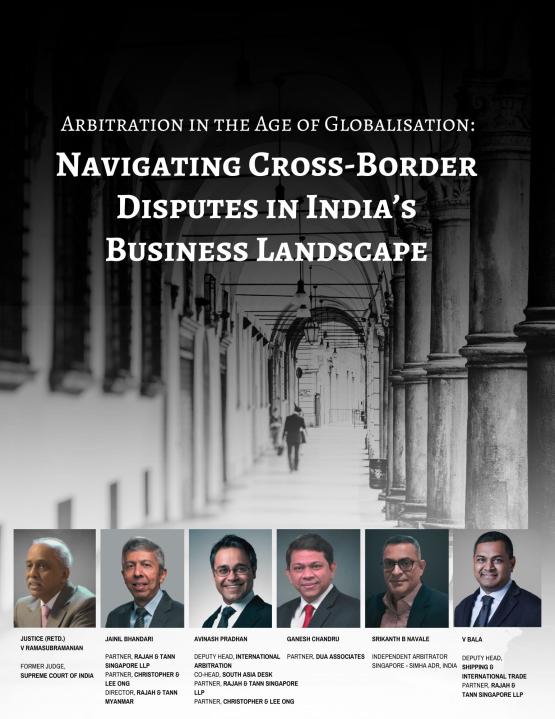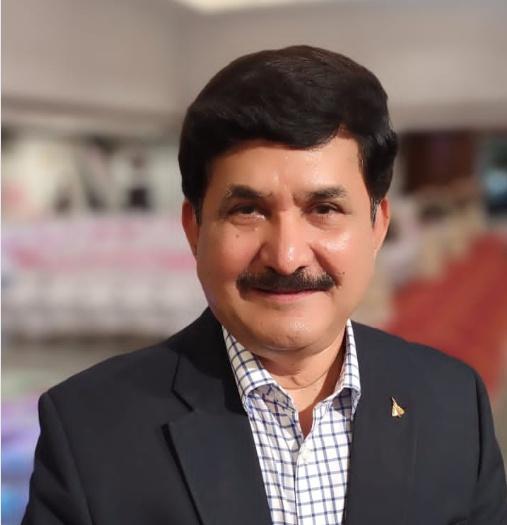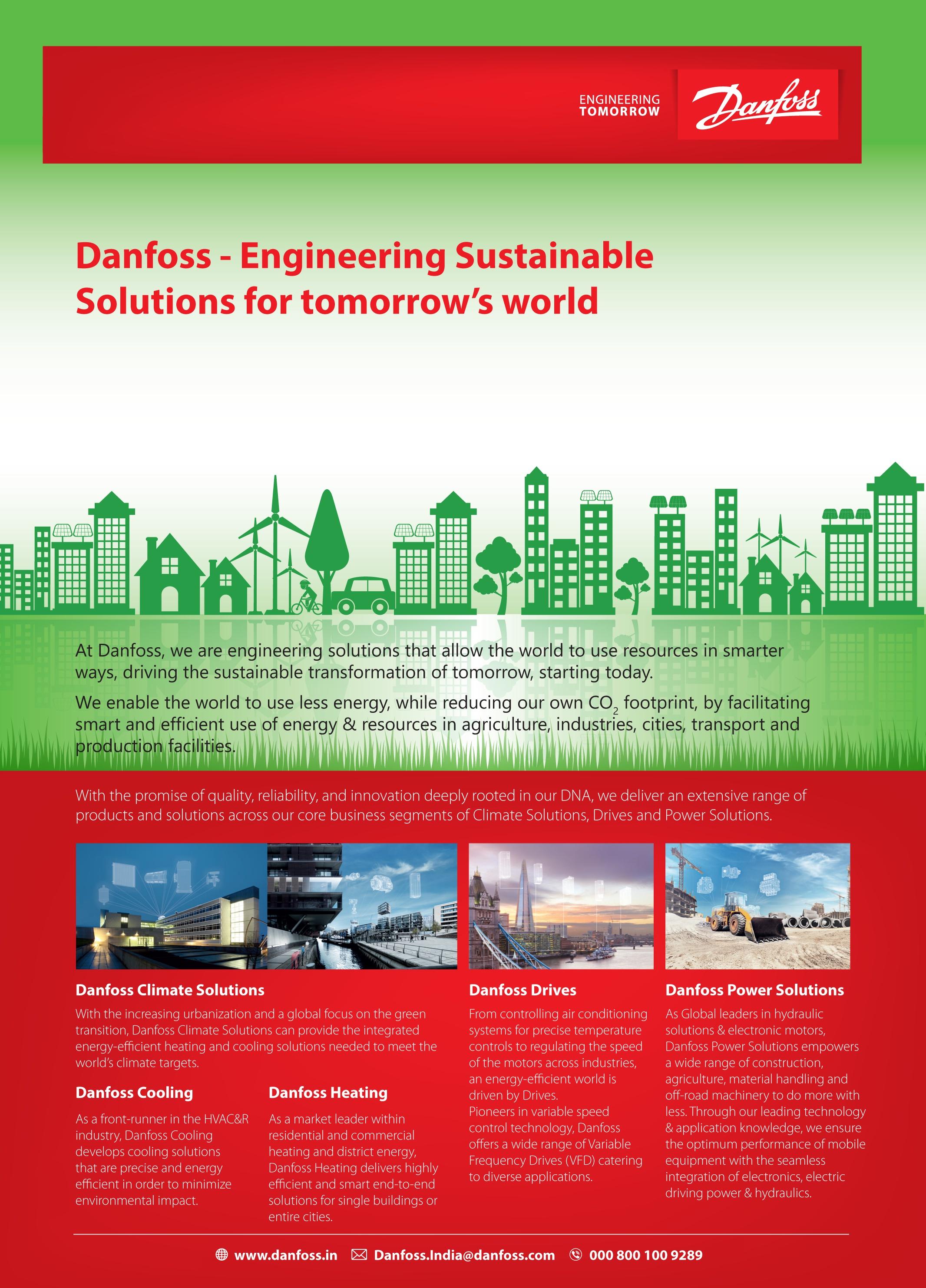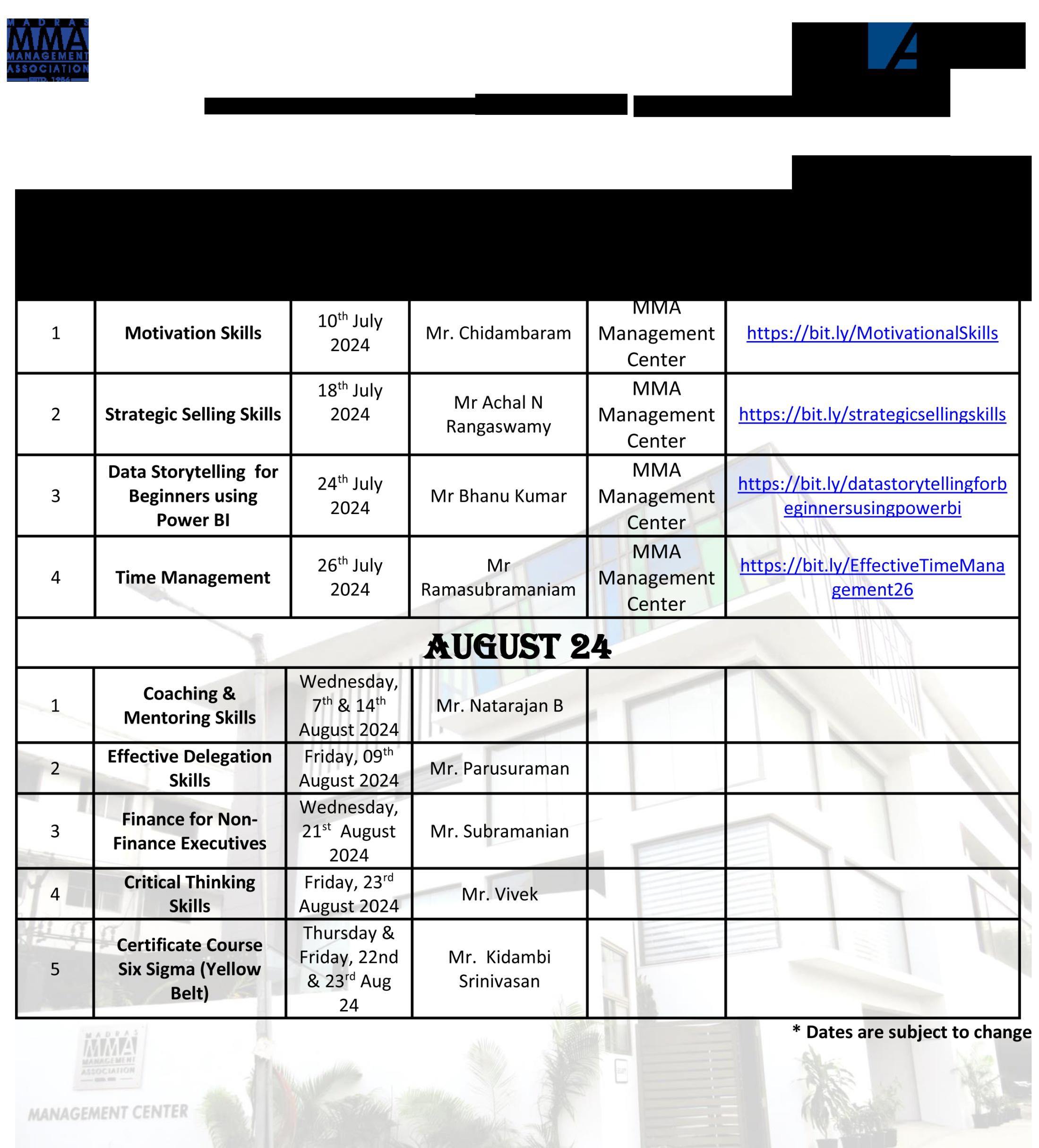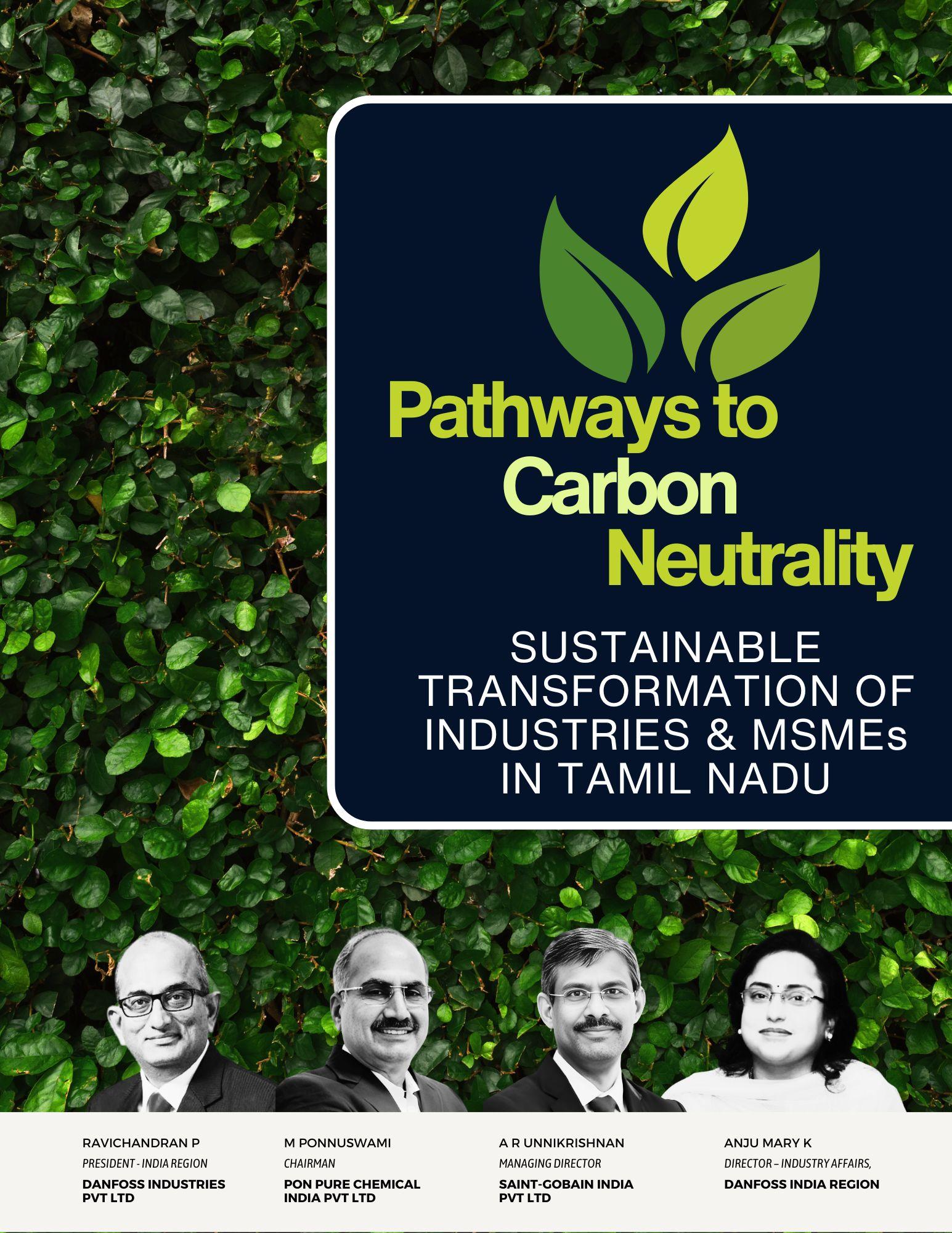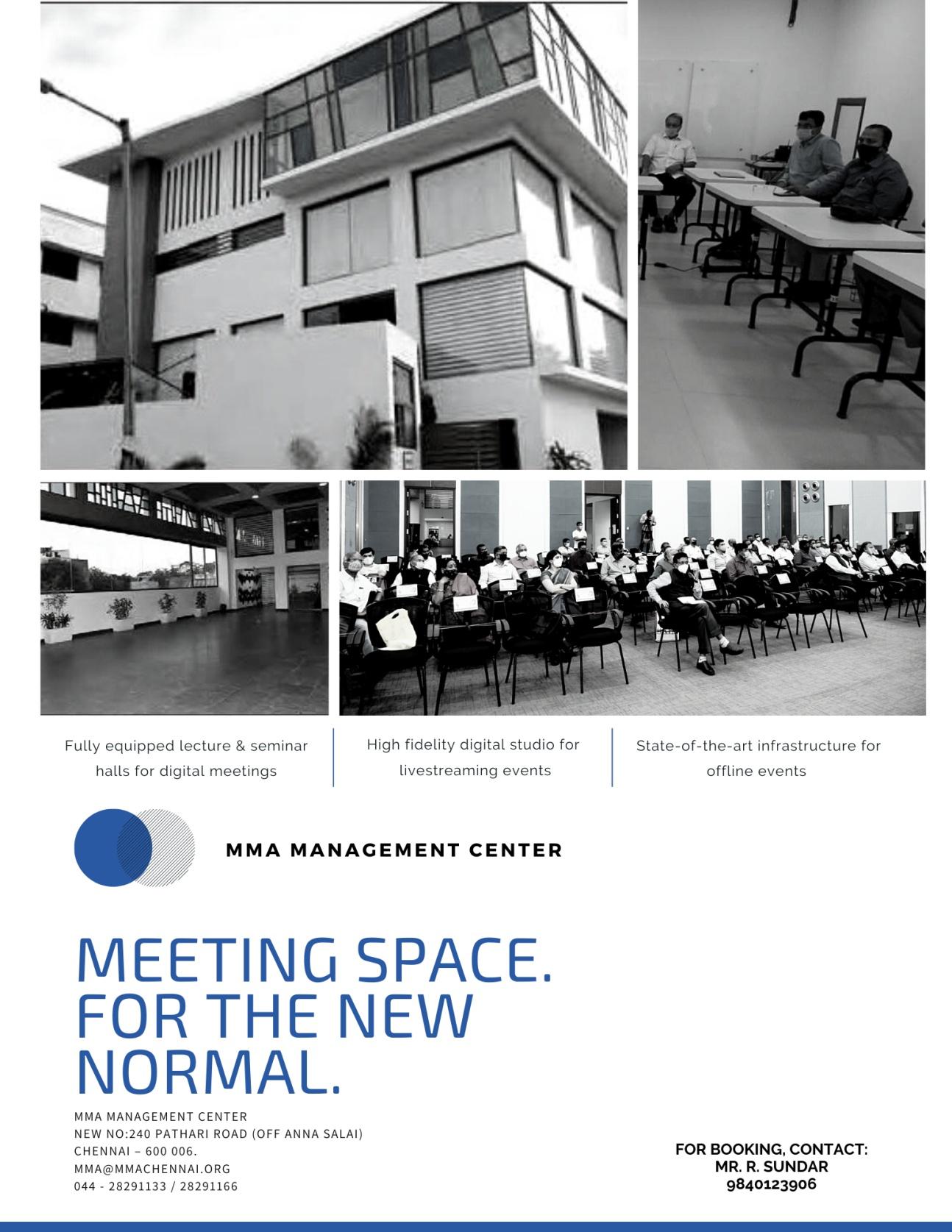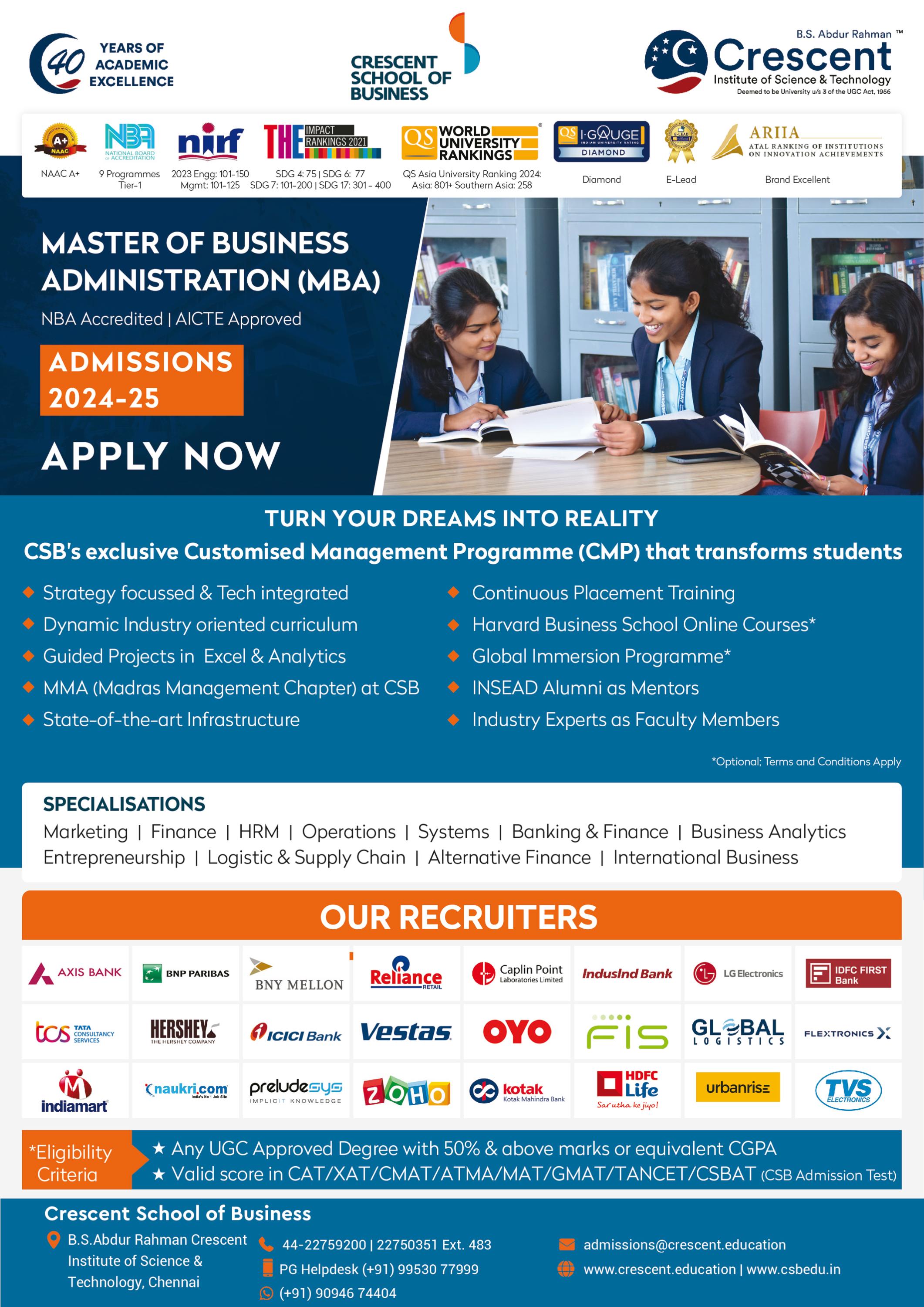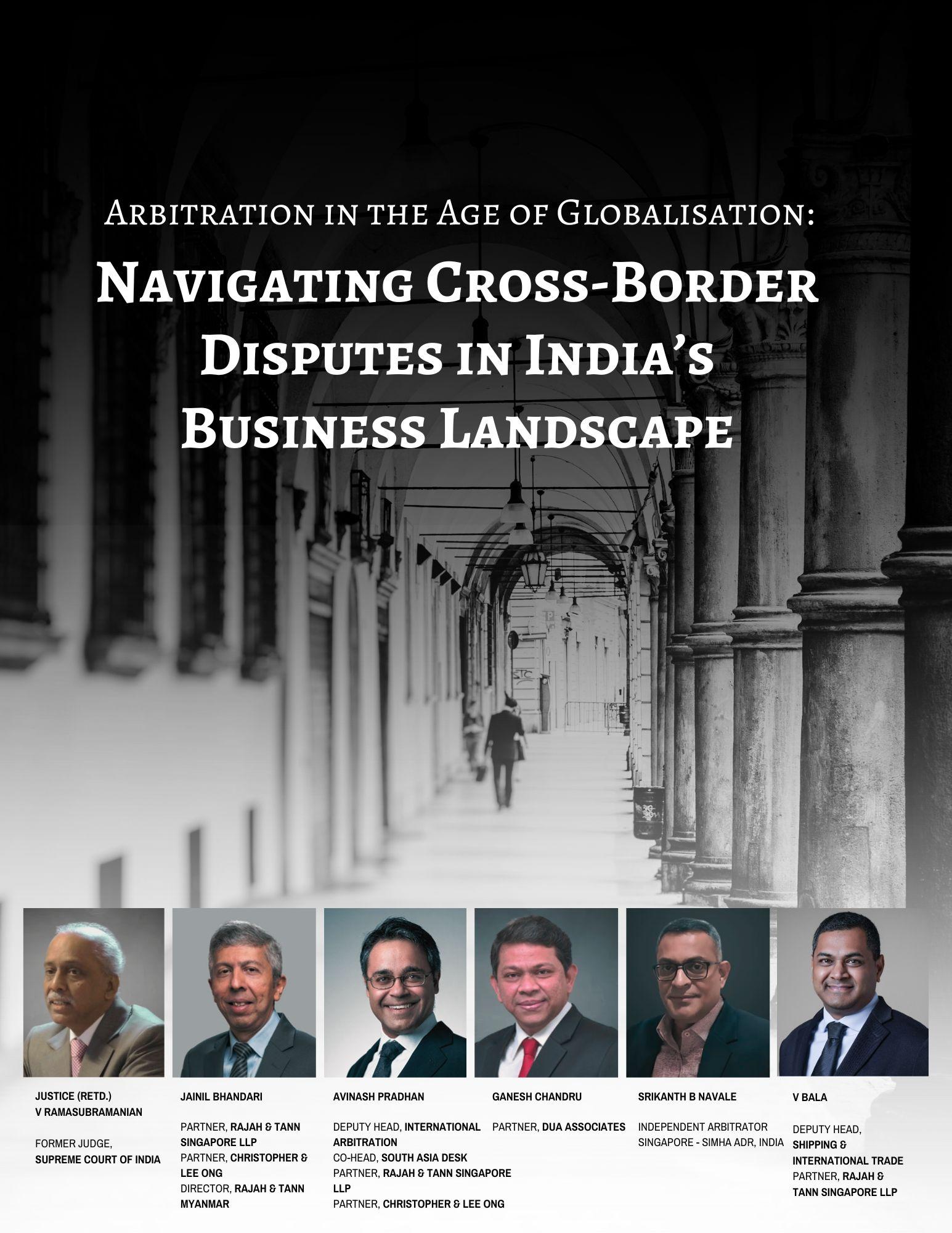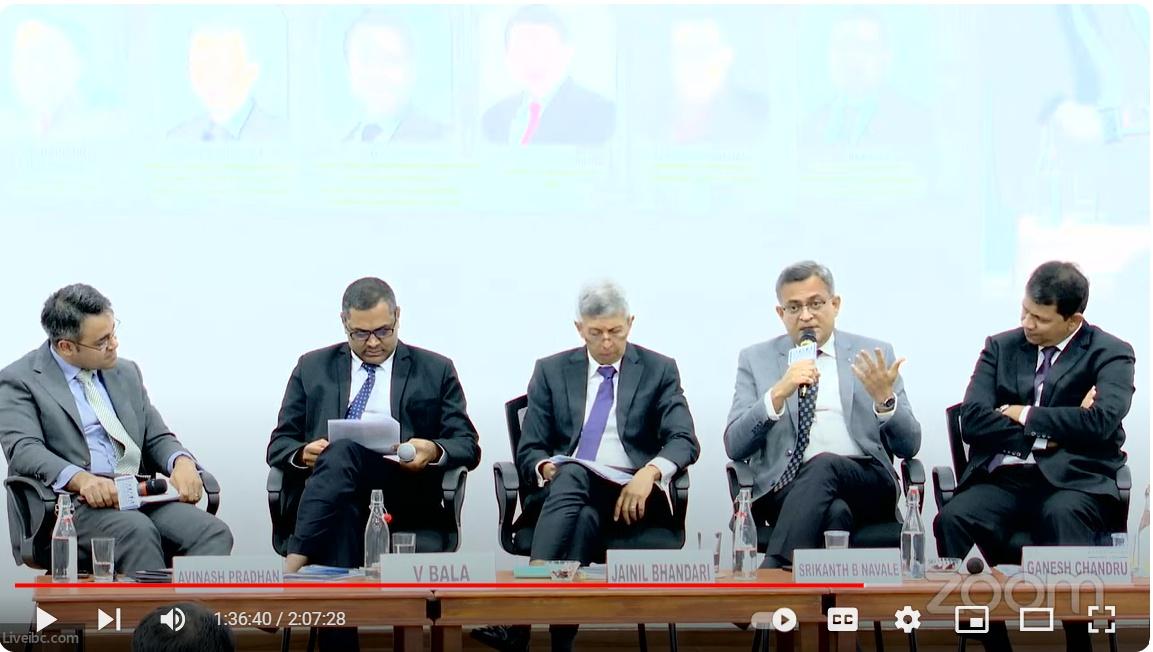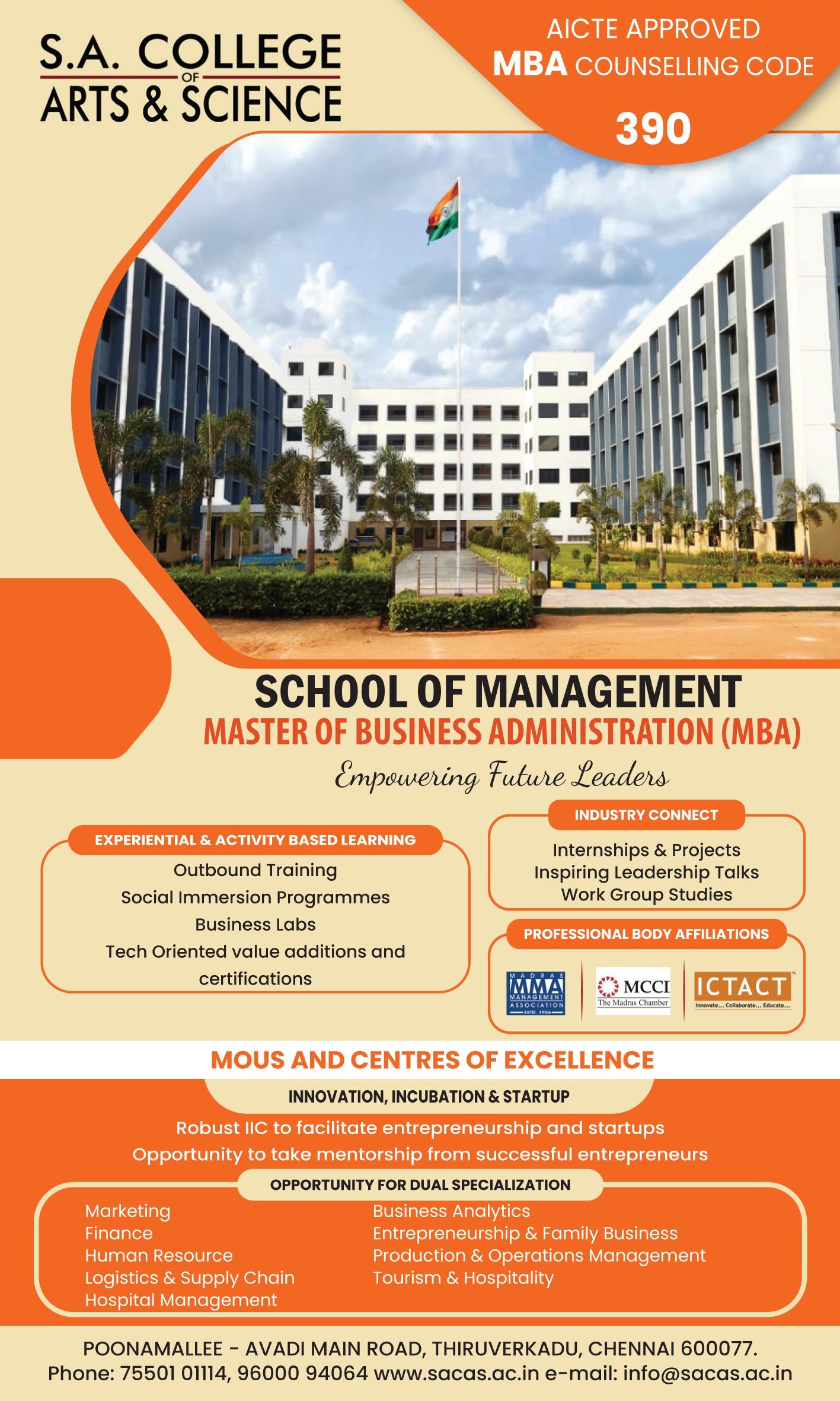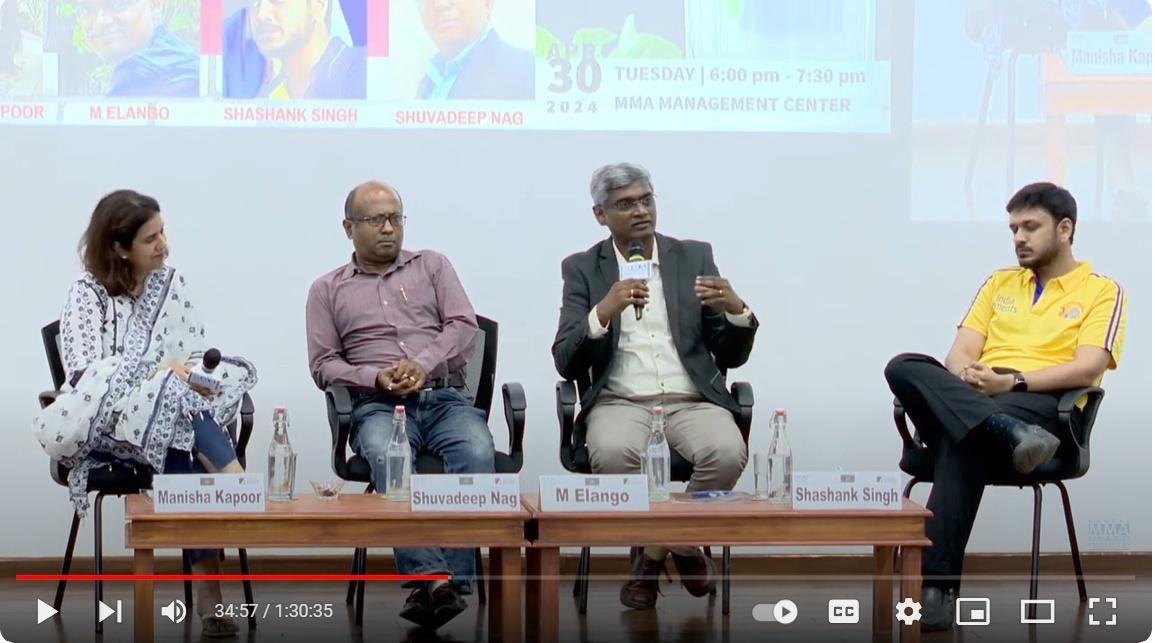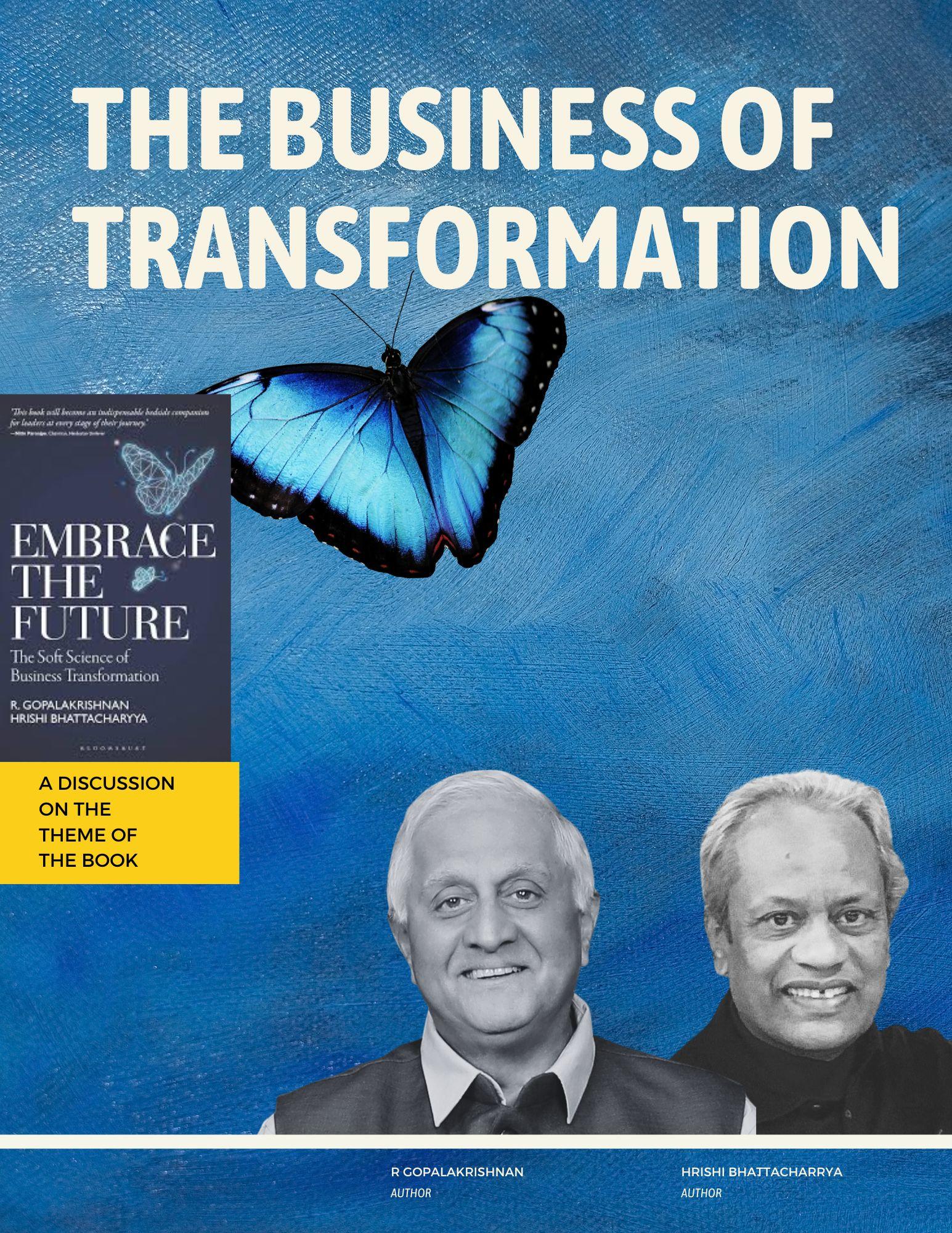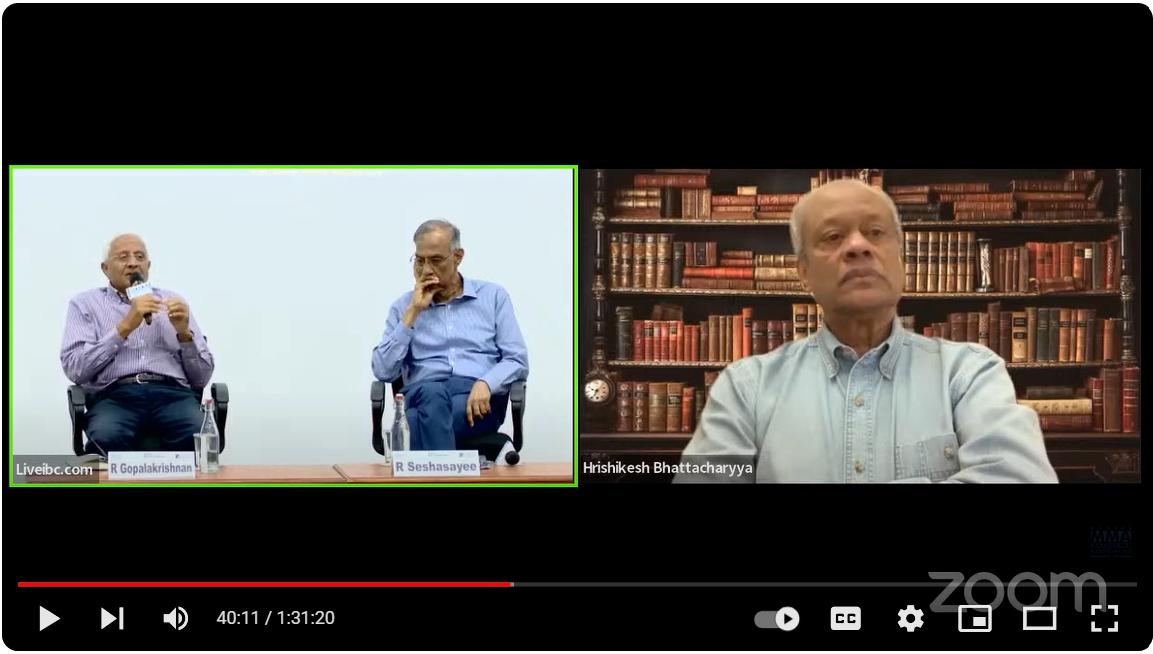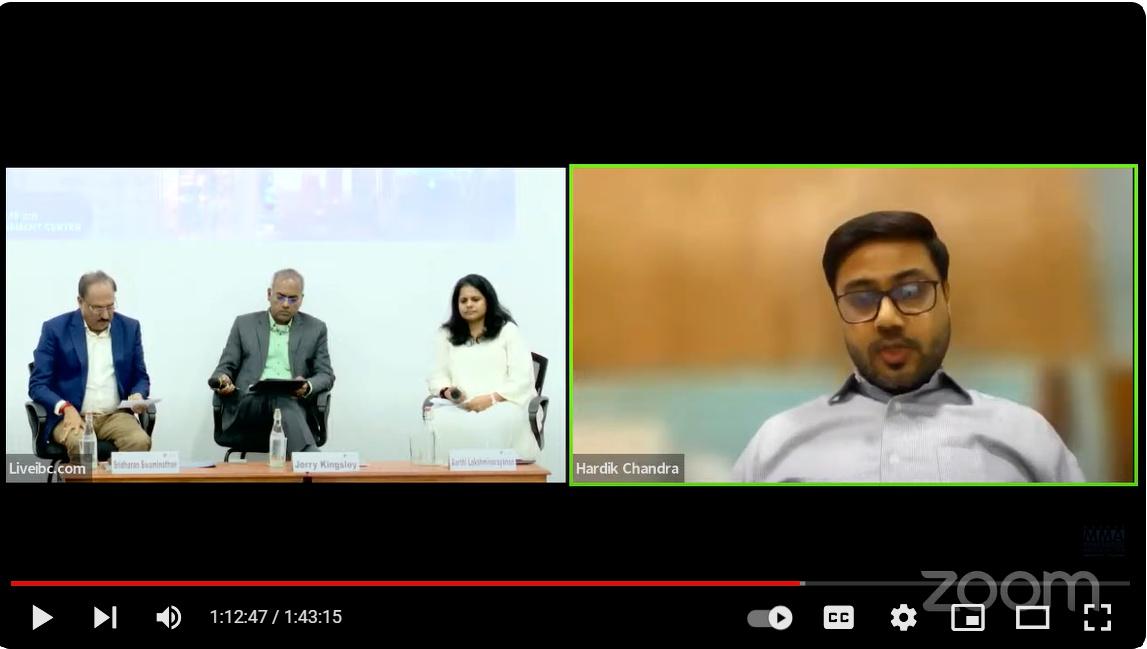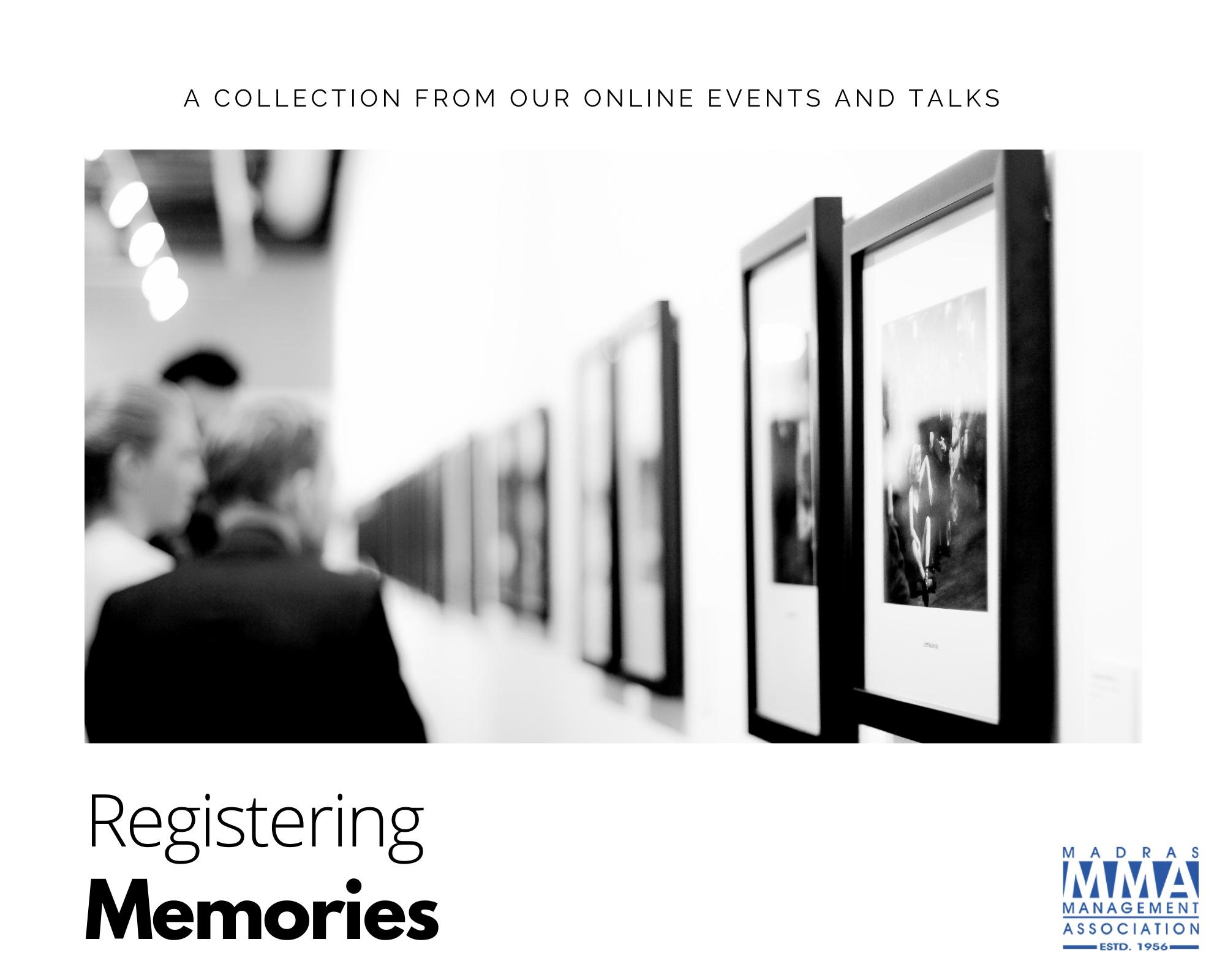Committed to Fulfilling Our Vision
As we conclude another successful financial year at MMA, I express my sincere gratitude for your unwavering support It is my pleasure and privilege to be associated once again with this special edition of the digital Business Mandate MMA has grown from strength to strength, carving a niche for itself as a multidisciplinary group focused on delivering high-quality management programs that benefit not only its members but also the wider public
Ranked as the number one organization among its peers in India, MMA remains committed to fulfilling the vision and mandate set forth by its founding members I extend my heartfelt thanks to the MMA members, past presidents, managing committee members, and secretarial staff for their invaluable contributions in achieving this milestone
The icing on the cake this year is the first-ever launch of the MMA publication “Turning Points: Management Lessons from Legends,” a collection of 21 insightful articles from the vast repository of MMA
Lectures This book is a must-read for management professionals striving for success, a definitive self-help guide, and a motivational tool for mastering the art of leadership and achieving enduring success in any endeavor
The book is now available on Amazon for ordering. Order your copy now and get inspired!
Among the management fraternity, the MMA Awards for Managerial Excellence stands as one of the most prestigious accolades, celebrating leaders in businesses, entrepreneurs, and professionals for their outstanding all-round performance. These awards recognize excellence, innovation, service, and commitment to stakeholders, and also acknowledge the remarkable business models driven by individuals who think differently, serving as an inspiration to all. The award nominees were subjected to a rigorous evaluation process using a unique and scientific methodology devised by Deloitte, our consultant for the awards
Gp Capt R Vijayakumar (Retd), VSM
The MSME sector plays a vital role in the socio‐economic progress of the nation. Technological advancement and policy changes are essential to steering the way forward and attracting more entrepreneurs.
MMA extends its heartfelt congratulations to the winners of the 22nd MMA Awards for Managerial Excellence: TVS Motor Company (Manufacturing Sector), Bimetal Bearings Ltd (SME Sector), Sify Technologies Ltd (Services Sector) and Sri Sairam Engineering College (Educational Institutions)
Triumph of Democracy
India has delivered a verdict for a third term under the leadership of Prime Minister Narendra Modi. While election results are not a direct mandate on the economic policies pursued by the Government, they do offer citizens an opportunity to voice their concerns over governance. With the 2024 election results, the electorate has made its voice heard, and the Government is now required to respond to these challenges
Indian democracy is more than capable of holding the government to account India's true victory lies in the strength of its constitution, which underpins the democratic process and ensures that the voices of its citizens are heard and respected
Arbitration & Dispute Resolution
The Ministry of Finance has recently issued new guidelines for arbitration and mediation in contracts related to domestic public procurements These guidelines apply to the Government, its entities, and agencies, including centres, public sectors, and public
sector banks The primary objective is to move away from traditional litigation to ensure the fair and efficient resolution of conflicts
We strongly believe that these principles should also apply to cross-border disputes in India’s business landscape. In this context, MMA organized a lively and thought-provoking discussion on the theme "Arbitration in the Age of Globalisation: Navigating Cross-Border Disputes in India’s Business Landscape" on April 25, 2024. The transcript of the discussion is published in this issue for your reading, offering insights into the power of arbitration in resolving issues.
MSME’s Small Business, Big Impact
Micro, Small, and Medium Enterprises (MSMEs) are the backbone of India’s economy, driving innovation, employment, and regional development. The MSME sector plays a vital role in the socio-economic progress of the nation. Technological advancement and policy changes are essential to steering the way forward and attracting more entrepreneurs. With adequate government support, skilled human capital, and the utilization of technology, MSMEs can address several challenges that hinder their growth and sustainability.
In recognition of the crucial role of MSMEs and on the occasion of World Environment Day 2024, MMA organized a seminar on the theme “Pathways to Carbon Neutrality: MSMEs and Industries Transformation in Tamil Nadu” on June 6, 2024 The seminar featured eminent speakers who shared valuable insights on innovative strategies, success stories, and collaborative opportunities for sustainable industrial growth and achieving a carbon-neutral Tamil Nadu
I am delighted to present in this issue an article on the discussion for the benefit of our readers Read on to get empowered and grow MSMEs in Tamil Nadu.
Brand Trust: The Cornerstone of Modern Branding
Branding in the modern era has evolved into a multifaceted endeavor that transcends the traditional realm of logos and slogans In today’s hyper-connected world, where consumers are bombarded with innumerable choices and information overload, establishing trust has emerged as a crucial strategic differentiator for brands To build this trust, it is essential to be finely attuned to the needs of modern consumers
The greatest asset any company can have is the trust of its customers Trust cannot be tricked or forced; it must be earned through consistent authenticity and delivering on promises time and time again. In response to widespread concerns about consumer rights being violated through misleading advertisements and unethical practices, the government is issuing final rules on misleading and surrogate ads, as well as unsolicited calls.
To address these issues, MMA organized a seminar on "Ad Wars: Making Competition Healthy." A galaxy of eminent speakers, including Ms Manisha Kapoor, CEO & Secretary General of The Advertising Standards Council of India (ASCI), shared their perspectives and the government's initiatives to curb deceptive practices in advertising. I am happy to present a summary of the discussion for your reading pleasure Please read on and get enlightened. National Eligibility cum Entrance Test
Alleged irregularities in this year's NEET-UG have led to massive protests across the country Students, parents, and coaching institutes have united in their opposition Concerns have been raised over the abnormally high scores, with 67 students achieving the highest possible mark of 720. Many students have
claimed that their calculated scores differed significantly from the declared results.
The introduction of NEET was intended to address the systemic issues that plagued the previous system. However, addressing these irregularities requires longterm solutions rather than temporary fixes that bypass comprehensive planning, skill development, and structural improvements. It is essential to ensure that the integrity of the examination process is maintained and that students can trust the fairness and accuracy of their results
Congratulations Team India!
After an eleven-year wait, a country that breathes cricket every moment finally celebrates victory. The Men in Blue have clinched the ICC T20 World Cup title Reflecting on Sir Garfield Sobers' quote, “If you take five wickets, someone has to take the catches If you score a hundred, someone has to be there with you”.
We see the essence of teamwork India's win was a testament to excellent team spirit.
Congratulations to Team India, consisting of outstanding cricketers who have worked tirelessly over the last few years to achieve this success Their passion, hard work, and the prayers of millions of fans have culminated in this glorious triumph
As always, we would be happy to hear your views, comments, and suggestions
Look forward to seeing you at the MMA AGM; your presence would add tremendous value to the occasion!
Happy reading!
Addressing climate change also presents a significant opportunity.
Ravichandran
Purushothaman
President, India Region, Danfoss Industries
COP26 held in Glasgow has set the target that India will be carbon neutral by 2070. This target is quite steep, and it has very significant implications for the country, its people, and its industry Let me try to unravel this in a few parts Firstly, achieving carbon neutrality means completely switching off energy that comes from fossil fuels. India's peak energy demand is 225 gigawatts
Remember, two-thirds of India is yet to be developed. Imagine the power generation infrastructure needed to build the rest of India. How are we going to make this transition from fossil fuels to non-fossil fuels? This is a significant challenge We aim for the economy to grow at 7%. Every unit of new energy must come from non-fossil fuel sources such as solar, wind, and nuclear Solar energy, however, is not available
Recognizing the Tamil Nadu ' s ambitious environmental goals, the event brought together senior industry leaders, policymakers, environmental experts, and MSME representatives to discuss innovative strategies, share success stories, and identify collaborative opportunities for sustainable industrial growth and achieving a carbon‐neutral Tamil Nadu
round the clock, posing a strategic challenge. On one hand, we must decouple growth from energy intensity
On the other hand, we must find alternative energy sources. The Government of India, along with the Ministry of Power, has developed a roadmap for achieving carbon neutrality
We Are Yet to Peak
India's emissions have not yet peaked. In developed economies like Europe or the USA, industrialization and emissions have already reached their peak. India's emissions are projected to peak between 2045 and 2047 Achieving net zero requires transitioning away from coal, fossil fuels, and oil-based energy sources Currently, 50% of India's greenhouse gas emissions come from electricity generation, predominantly from coal Coal accounts for 60 to 65% of India's electricity generation Additionally, 10% of emissions stem from diesel engines, with mobility contributing 20%, industries 16%, and agriculture making up the remainder To transition to green energy generation, shift to electric mobility, and decarbonize industries, significant capital is required. In 2024, global

investments in energy amount to $3 trillion, which is roughly 2.8% to 3% of the world's GDP of $100 trillion annually Notably, for the first time, $2 trillion of this investment is directed towards non-fossil fuel sources, marking a substantial shift. However, $1 trillion continues to be allocated to building coal plants, underscoring the challenge of moving away from coal quickly Solar energy, while promising, presents geopolitical challenges as materials are currently sourced predominantly from a single country, which controls the raw materials and resources essential for solar technology. Apart from the economic challenges posed by greenhouse gas emissions, we also face geopolitical challenges in balancing trade Fundamentally, there are four or five key areas that we must focus on as a country.
Technology Driven
Firstly, this is a technology-driven endeavour In electric mobility, the primary challenge today lies in battery technology. Now we are in a situation where batteries are being fixed while the vehicle is in use, akin
to fixing an engine while a plane is flying. Nevertheless, there are available technologies that can help reduce energy demand from fossil fuels The Government of India introduced PAT (Perform, Achieve, and Trade) schemes, encouraging industries to invest in technologies aimed at reducing energy consumption. Examples include the widespread adoption of LED bulbs, improvements in cooling systems, and the energy efficiencies driven by digitalization. Technological advancement remains pivotal in addressing these challenges
Collaboration with Universities
Secondly, as technology continues to evolve, it is crucial to engage extensively with universities Building technical skills in India is essential because our current ecosystem lacks the necessary expertise to navigate future technologies effectively Collaborating closely with universities is therefore pivotal in addressing strategic technology challenges and enhancing our skill base.
Funding
Thirdly, funding presents one of our most significant challenges. India remains a developing country, and conditions like CBAM (Carbon Border Adjustment Mechanism) imposed by developed nations necessitate support for us to transition towards carbon neutrality Attracting investments and facilitating financial flows into this sector thus becomes the third critical challenge we face.
Favourable Public Policy
Fourthly, public policy plays a crucial role In India, large companies have embraced initiatives like PAT, setting examples in energy efficiency. India leads globally in energy-efficient production of cement, steel, and glass However, India's economy is not solely defined by large corporations but also by its extensive small and medium-scale industries (MSMEs), contributing 60% to our GDP Engaging MSMEs in this transformative journey poses significant challenges.
We need numerous startups and innovations in business models. For instance, "cooling as a service" allows users to avoid purchasing large cooling equipment by paying a service provider to maintain a building, say at 24 degrees Celsius. Digitalization enables such innovative business models However, for these models to flourish, supportive public policies are crucial. Imposing high taxes like a 28% GST on new business models such as "cooling as a service" would stifle innovation and hinder progress toward sustainability
Compliance Issues
Fifthly, compliance is a significant issue While the government recommends setting ACs at 24 degrees Celsius, many people prefer lower temperatures. In
To effectively reduce greenhouse gases, decisive action is needed. This is a highly complex challenge for India...
~
Ravichandran Purushothaman
Chennai, for instance, maintaining ACs at 25 degrees Celsius and using fans on low speed can enhance airflow and circulation Although India has Energy Conservation Building Codes (ECBC) for buildings, compliance remains inconsistent. Cooling is increasingly necessary and no longer a luxury, impacting all segments of society, especially the most vulnerable To effectively manage energy consumption related to cooling and other emissions, stringent public policy measures are essential This approach is crucial for achieving comprehensive control over energy use and emissions across various sectors.
Climate change is a real and pressing issue. To effectively reduce greenhouse gases, decisive action is needed. This is a highly complex challenge for India, as we are an emerging economy and our emissions have yet to peak Transitioning to non-fossil fuel solutions is essential While we may not be considered a technology powerhouse and face challenges with limited capital and high costs, we urgently require technology, skills, innovation, and startup initiatives However, addressing climate change also presents a significant opportunity for economic development. Achieving Net Zero and mitigating greenhouse gases are key economic challenges Therefore, it is crucial to prioritize and intensify efforts in this area moving forward.
Sectorspecific initiatives should be prioritized.
A R Unnikrishnan MD, Saint Gobain
I work in the glass industry, where our sector contributes around 16% carbon emissions, though it may seem relatively small However, with increasing manufacturing activities in India, particularly in Tamil Nadu, it's crucial that we take immediate action to achieve carbon neutrality by 2070. Manufacturing is highly technical, necessitating a structured framework to progress effectively. Typically, industry emissions are categorized into three scopes: Scope 1 covers
emissions directly from the manufacturing process itself, Scope 2 includes emissions from the energy consumed, such as electricity, and Scope 3 encompasses emissions from the supply chain. Each of these categories requires targeted strategies for reduction and mitigation
Scope 1
In Scope 1, there is significant opportunity for immediate action within our industry Let me provide some examples of what we have implemented in our manufacturing practices. Typically, a plant has a lifespan of 20 to 30 years Therefore, if our goal is to
achieve carbon neutrality by 2040 or 2050, we must start planning and implementing changes now
Secondly, we need to anticipate the types of energy sources and fuels that will be available in 10 or 15 years Our plant designs, technologies, and processes must incorporate forward-thinking strategies to align with future energy requirements and advancements. We require a proof of concept, which involves conducting specific tests For instance, we conducted a test in our plant in Germany to assess the feasibility of running our glass furnaces on hydrogen. We have confirmed its viability, and once hydrogen becomes commercially available, we will be prepared to adopt it
Traditionally, many industries in Tamil Nadu have heavily relied on fossil fuels. To transition to cleaner alternatives, we need to proceed in phases An immediate step is shifting towards natural gas, which represents a cleaner fuel option. As a state, we have been somewhat behind in this transition due to limited infrastructure for widespread natural gas availability
However, the situation is evolving New pipelines are being laid out, and I am optimistic that Tamil Nadu will soon join the national gas grid in the coming months Currently, industrially advanced states like Gujarat, Maharashtra, and Karnataka are already integrated into this grid, whereas Tamil Nadu is not yet connected.
Hydrogen Options
Looking ahead to hydrogen, the current price stands at approximately $5 to $6 per kilogram. For widespread adoption by industries, this price needs to drop below $2 per kilogram, which may require significant technological advancements, which is not foreseen in the near future Additionally, government policy interventions are crucial Subsidies or incentives
Fostering more startups focused on sustainability and offering innovative sustainable solutions is essential.
~ A R Unnikrishnan
could incentivize industries to invest in transitioning to hydrogen within a defined timeframe Tamil Nadu possesses the capability to establish these facilities effectively.
For instance, I recently learned about a new technology capable of producing hydrogen from industrial effluents, currently in its pilot phase I am confident that within the next 5 to 10 years, this technology will be scaled up for widespread use. Many MSMEs in industrial clusters lack effluent treatment plants (ETPs) By implementing ETPs, these clusters could potentially generate hydrogen from industrial effluents.
Furthermore, within Scope 1 emissions, it's crucial to explore alternative raw materials In our glass manufacturing, we have already started substituting carbonaceous raw materials with non-carbonaceous alternatives This transition requires extensive research in science, chemistry, and technology. Another viable approach is enhancing recycling efforts to promote a circular economy Lastly, integrating biofuels into Scope 1 processes holds promise India has abundant agricultural waste that can be converted into biofuels, with pilot-scale technologies already available for deployment These initiatives collectively contribute towards reducing carbon emissions and advancing
Scope 2
Scope 2 mainly encompasses the electricity we procure from TNEB (Tamil Nadu Electricity Board). Tamil Nadu has made significant strides in its energy mix by incorporating a higher proportion of renewable sources and nuclear energy. Renewable now stand at approximately 43% in Tamil Nadu’s energy mix This percentage is notably higher compared to other states in India. Despite these advancements, land availability poses a constraint, limiting the expansion of solar farms within the state Given the preciousness of land, largescale solar farm installations face challenges
However, there are two promising opportunities to explore. Firstly, offshore wind energy presents a viable option for both Tamil Nadu and Gujarat Secondly, there exists a policy framework for interstate electricity transfer. Many state governments are not acting this proposal. It offers an avenue for Tamil Nadu to take a leading role Collaborating with states like Maharashtra and Rajasthan, which have extensive barren lands, could facilitate the establishment of large solar farms. This approach would enable electricity generation in these states to be transmitted and utilized in Tamil Nadu, using the transfer scheme.
Scope 3
In Scope 3, we must collaborate closely with our supply chain partners. Firstly, leading manufacturing companies must commit to decarbonizing their supply chains by working with key vendors to reduce the embedded carbon content in raw materials delivered to their factories.
Secondly, addressing emissions from transportation is crucial Unlike Delhi and many other regions that
transitioned to CNG years ago, Tamil Nadu currently lacks a comprehensive CNG network Establishing a robust network of CNG and LNG across the state is essential. This initiative would facilitate the transition of both goods and eventually people to cleaner fuels, starting with CNG and eventually progressing to electric vehicles. While electric mobility presents its own set of challenges, developing a CNG infrastructure is a critical initial step towards reducing emissions in transport
Additionally, it's crucial to address high-carbon sectors such as cement and steel. Sector-specific initiatives should be prioritized to effectively reduce their carbon emissions Furthermore, fostering more startups focused on sustainability and offering innovative sustainable solutions is essential. By integrating these efforts, Tamil Nadu can lead the way in achieving carbon neutrality These collective actions across industries and startups will play a pivotal role in advancing sustainable practices and environmental stewardship in the region
MSMEs Have a Big Role to Play
M Ponnuswami
CMD, Pon Pure Chemicals
Manufacturing constitutes 30% of Tamil Nadu's GDP, whereas it is just 18% of India's GDP MSMEs contribute to 45% of our exports and 29% of our manufacturing. MSMEs have the capability to manufacture good products at very competitive prices, and the MSME ecosystem in Tamil Nadu is very strong.
MSMEs working towards carbon neutrality will be advantageous and more profitable for them Globally, customers also insist on carbon neutrality I came across a company that makes garments from recycled
I suggest that larger industries and associations must educate MSMEs on sustainable materials, technologies, and practices available for them to adopt.
~ M Ponnuswami
PET bottles; they have a turnover of 250 crore. Our Prime Minister wears coat made from their garment and thus, they have become very famous I see a lot of opportunity for MSMEs in recycling In Tirupur, for dyeing fabric, they were previously using 100% water without recycling. Now, thanks to court intervention, they recycle 95% of the water they consume
I come from a village, and nearby there is a paper mill. As a student, I used to see a mountain of sludge dumped there, which would be cleared by tractors. Nowadays, it is not there When I asked about it, they said they are sending the sludge to cement factories, where it is used instead of mining lime. We can see many such ideas successfully implemented
Lighter Blades & Lesser Energy
Recently, I visited an energy-efficient light and fan manufacturer that has a turnover of 500 crore Their market share in Tamil Nadu is 50% Previously, they used steel blades for fans, but now they use lightweight aluminium blades sourced from Indalco and paint them. They claim that this reduces energy consumption by 38% MSMEs can consider adopting similar innovations or become suppliers to such companies engaged in energy-efficient manufacturing.
I visited an MSME in Coimbatore that has completely digitized their plant, investing two crores
in digitization They no longer print drawings; instead, they are sent directly to the machines for manufacturing, after which the products undergo painting or electroplating. They are a debt-free company Digitizing manufacturing will have a significant impact on making MSMEs more profitable and sustainable. MSMEs must embrace digitization.
I also visited an MSME that manufactures steel tubes used in refineries and pharmaceutical industries They claim their pipes can withstand corrosion for 40 years, compared to conventional pipes that last 20 years. I suggest that larger industries and associations must educate MSMEs on sustainable materials, technologies, and practices available for them to adopt. The government is keen on incentivizing MSMEs that embrace net zero emissions
Farm Mechanisation
From our factory, we supplied chemicals from Chennai to a major corporation in Guwahati They aimed to reduce fuel costs and road transport, so they requested shipment to Calcutta port. Now, customers insist on reducing our carbon emissions due to their commitments and reporting requirements
One company in India imports used cooking oil, produces biodiesel, and exports 100% of the product. There are abundant opportunities for MSMEs in various sectors We also need to educate the agriculture sector on efficient power use and water conservation. MSMEs can become agricultural service providers, offering complete mechanization services In my village, I observe sugarcane farmers burning crops before harvesting, causing loss of sugar content and pollution. The government provides subsidies for biogas and it plans to blend it with natural gas Mechanizing farming can minimize pollution and waste generation
Investors, lawyers in the arbitration circuit and the arbitrators have a duty to strike a balance
Justice ﴾Retd﴿ V Ramasubramanian
Former Judge, Supreme Court of India
Tamil Nadu has always been one of the favoured destinations for foreign investments Therefore, one would have expected Chennai to be one of the top destinations for arbitrations also, but ironically, while the flight of capital is towards the southern part of India, the flight of arbitration is towards north of India
As India continues to develop as a leading economy and destination for foreign investment, the need for effective dispute resolution mechanisms has become increasingly important. International arbitration has emerged as a preferred method for resolving disputes, particularly in cross‐border transactions, but also in domestic disputes
Today India has become one of the fastest growing economies in the world The IMF executive director was quoted by CNBC on March 1, 2024 as saying, "If you look at the GDP numbers, India is poised for about 8% growth this year ” That makes India easily the fastest growing economy in the world
Since 1991, the economy has grown by leaps and bounds. Total FDI inflows into the country from April 2000 to December 2023 was US $ 971 5 billion Out of this, the total FDI inflows received from April 2014 to December 2023 constituted about $ 448 billion. Mauritius contributed 26%, Singapore 23%, USA 9%, Netherlands 7% and Japan 6% All these countries emerged as top five countries for FDI equity inflows into India for the year 2023-24. History shows that many times the flow of capital is followed either by aggression or litigation India is no exception to this general rule. After our economy opened up in 1991, India entered into a series of Bilateral Investment
Treaties (BITs). By the year 2015, India had signed 83 BITs and several international investment agreements
The first ever BIT was with the United Kingdom in 1994 In the year 2003, India developed its own model BIT. The first ten years from 1994 to 2004 perhaps proved to be a period of honeymoon between the Republic of India and the investors
The Dabhol Power Plant Fiasco
But this honeymoon ended in 2004 with the initiation of the first round of BIT arbitration in 2004, in the Dabhol Power Plant case. Planned as a joint venture between Maharashtra Power Development Corporation, Enron, General Electric, and Bechtel, Dabhol Power Corporation aimed to set up a huge naphtha-based plant in the first phase and another huge gas-based plant in the second phase As the largest foreign investment in the country at that time, Enron was given top priority in terms of clearances. But the power purchase agreement between Enron and the
Maharashtra State Electricity Board was kept under the wraps The party in opposition at that time promised to cancel the project When they came to power, it was revealed that Maharashtra State Electricity utility was paying Rs 7.80 per unit to buy power from Enron, while charging retail consumers Rs 1 89 per unit By contrast, the cost of power purchased from the other producers like the National Thermal Power Corporation and the Bombay Suburban Electric Supply varied from 80 paise to Rs 3 per unit
At around the same time, in the US, Enron was found guilty of a huge accounting and corporate fraud and it went into bankruptcy. The agreement was terminated However, other investors like Bechtel and General Electric brought claims against India, under the India-Mauritius BIT, alleging expropriation of their interest in the power plant by the Indian government The claims were however settled and India had to compensate for the losses.
White Industries vs. India
The second most important BIT arbitration case involved the Australian company, White industries. In 1989, the Australian company entered into a contract with Coal India Limited. Though the contract was governed by Indian law, the contract specifically excluded the operation of the Indian Arbitration Act 1940, which was the law at that time, but it contained an arbitration clause requiring the parties to arbitrate all disputes under the ICC arbitration rules.
Therefore, when the disputes arose, they were referred to an ICC tribunal in June 1999 An award was passed in 2002 which was challenged before the Calcutta High Court. The Australian company filed an application before the Delhi High Court to enforce the award The Australian company moved an application first for transfer of the Section 34 petition from the Calcutta High Court to the Delhi High Court. Thereafter, they moved the Calcutta High Court itself for rejection of the application to set aside the award. The Calcutta High Court dismissed the application for rejection of the petition under section 34 The Division bench confirmed it
The Australian company filed an appeal in the Supreme Court. The appeal was referred in the year 2002 to a larger bench Nine years passed In the year 2009, contending that the inability of the Indian courts to enforce an award for a period of almost seven to nine years tantamounts to a breach of articles 3,4,7 and 9 of the BIT The Australian company launched a claim for a sum of Australian $10 million upon the Republic of India.
As there was no response from the Indian government, the Australian company invoked Article 12, which provided for the reference in the dispute to
an ad hoc tribunal constituted under the arbitration rules of UNCITRAL Before the arbitral tribunal, the Australian company advanced two arguments: one related to the violation of Fair and Equitable Treatment (FPT) clause under Article 3 2 It was contended by the Australian company that the entertainment by an Indian court of an application to set aside the award and the shocking delay on the part of the Indian courts in dealing with the application for enforcement of the award amounted to denial of justice; and as a consequence, it violated the fair and equitable treatment standard
The second important contention of the Australian company was that the Indian courts' delay of nine years, in enabling them to enforce an international arbitration award was directly attributable to the failure of the country to provide effective means of asserting and enforcing the rights under the award and that, therefore, it constituted a breach of article 42 of the BIT Interestingly, article 42 of the BIT between India and Australia did not contain a clause for the provision of effective means of asserting claims and the enforcement of rights
But the Australian company drew parallel from article 45 of the agreement between the Republic of India and the State of Kuwait and contended that there was an obligation on the part of the Republic of India to treat investments made in its territory on a basis no less favourable than those accorded to investments of investors of any third country. In other words, they claimed that the investments of all countries deserve equal treatment Interestingly, the arbitral tribunal rejected the claim of breach of Article 32: FET standard, which revolve around the failure of the Indian courts to dispose of the matter But the tribunal upheld the contention revolving around article 42.
Vodafone & Other Cases
After the White Industries case, there have been several BIT arbitrations, such as the Republic of India vs Louis Dreyfus Armateurs SAS case under the IndiaFrance BIT, the Deutsche Telekom vs Republic of India under the India-Germany BIT, and the Khadamat Integrated Solutions Private Limited vs. Kingdom of Saudi Arabia under the India-Saudi Arabia treaty
In 2019, there were also significant interstate investor-state disputes Khaitan Holdings Mauritius issued a notice of dispute to the Republic of India under the India-Mauritius BIT. The Republic of India moved the Delhi High Court seeking an anti-arbitration injunction However, the Delhi High Court, relying on the precedent set by Vodafone, rejected the application for injunctions.
Another interesting set of investment arbitrations occurred in the Nissan Motor Company case, where the concept of Fair and Equitable Treatment was scrutinised
Then came the Vodafone arbitration case, which became a classic example due to the nuances it presented. The original arbitration was conducted under the India-Netherlands treaty While this arbitration was pending, Vodafone initiated another investment arbitration under the India-UK BIT, challenging the retrospective effect of an amendment made by the Indian government under Section 91 of the Income Tax Act 1961, read with Section 195 of the Finance Act 2012.In 2018, the Indian government sought an antiarbitration injunction from the Delhi High Court against Vodafone for commencing two simultaneous arbitral proceedings one under the India-Netherlands treaty and another under the India-UK treaty. However, the Delhi High Court rejected India's arguments, affirming the principle of competence and emphasizing that intervention in BIT arbitrations is severely restricted The court held that the provisions of the Arbitration Act do not apply to BIT arbitrations.

As of 2014, there were about 17 known BIT claims against India. The fallout of these spate of arbitrations was an increased national concern.
by the Permanent Court of Arbitration in Singapore. The arbitration was conducted under the India-Japan Economic Partnership Agreement concerning alleged non-payment of incentives under the Indian tax regime The Republic of India's objection to the jurisdiction of the PCA in Singapore was ultimately dismissed.
The New BIT Regime
As of 2014, there were about 17 known BIT claims against India. The fallout of these spate of arbitrations was an increased national concern Therefore, between 2012 and 2016, India revisited its BIT regime, which led to two main outcomes. The first was the adoption of a new model BIT in December 2015 with the twin objectives of: one, affording appropriate protection to foreign investors in India and two, maintaining a balance between investors’ rights and the government's obligations
The objective was to terminate old BITs where the initial duration had concluded or issue joint interpretative notes/statements for renegotiation based on the model BIT where the initial term of the BIT was still in effect Since 2016, India has terminated 77 bilateral investment treaties. It has entered into several new generation BITs with the states such as Belarus, Brazil, Taiwan and Kyrgyzstan In May 2022, India entered into a Comprehensive Economic Partnership Agreement (CEPA) with the United Arab Emirates; and Economic Cooperation for Trade Agreement (ECTA)
with Australia on 29 December 2022 The current model BIT of 2016 comprises 38 articles and seven chapters, designed to strengthen the negotiating position of states. This model BIT incorporates the Solini criteria, established in a landmark case involving Solini and the Kingdom of Morocco. The Solini test is utilised by tribunals to interpret the term "investment" under Article 25(1) of the ICSID Convention To meet the Solini test, an investment must fulfill four criteria: (1) a contribution, (2) a certain duration, (3) risk, and (4) a contribution to the economic development of the host state The model BIT now excludes pre-investment activities from the purview of investments and has eliminated the Most Favoured Nation (MFN) clause. Another provision that has come under criticism is Article 15 2 of the model BIT, which mandates that an investor must first seek legal remedies from the domestic courts of a host state for an initial period of five years before initiating a claim under the model BIT The model BIT of 2016 has also introduced a distinction between direct and indirect expropriations.
Criticisms and Challenges
India's model BIT has faced significant criticisms for being overly focused on protecting the interests of the host state. Some critics argue that India's actions post-2016 have led to a decline in foreign direct investment (FDI) inflows into the country, while others dispute this claim. In the budget speech for 2024-25, the Union Finance Minister highlighted that FDI inflows from 2014 to 2023 amounted to $596 billion, twice the amount recorded during 2005 to 2014. Interestingly, the finance minister also introduced a different interpretation of the acronym FDI: "First Develop India "
Three areas that persistently challenge the BIT arbitration regime are public health, human rights, and environment. When arbitral awards involve these areas,
there is often significant outcry alleging that such awards favour powerful entities at the expense of democratic principles, leading to perceived discrimination between nationals and foreigners Critics argue that multinational corporations can exert undue pressure on governments to protect polluting industries, thus harming the environment. This theory is advanced by opponents of the regime, particularly concerning issues of public health and environmental protection. Therefore, investors, lawyers in the arbitration circuit and the arbitrators have a duty to strike a balance
I’m not sure how many of you have heard about Mr. Samuel Gompers, a Jewish immigrant and trade union leader who founded the American Federation of Labour He made a notable remark about arbitration He said, “Do I believe in arbitration? Yes, I do. But not in the arbitration between the Lion and the Lamb, in which the lamb is in the morning found inside the lion ” Although he spoke in the context of arbitration between
workers and management, such a scenario should not happen in investment arbitrations also.
Arbitration is the optimal approach in handling crossborder disputes
Mr. Jainil Bhandari
Partner, Rajah & Tann Singapore
Arbitration is a consensual dispute resolution process based on the parties’ agreement to submit their disputes to an arbitral tribunal, usually composed of one or three independent
Unlike court judgements which only apply in the host country, the arbitration award is enforceable internationally as most countries are signatories to the New York convention for arbitration.
arbitrators appointed by or on behalf of the parties. The parties’ agreement is paramount. It is flexible and there are no specific rules of evidence and there are no strict rules on the form of documents The result is an award, that is the final decision and legally binding on the parties. Unlike court proceedings, arbitration is flexible. There are two approaches:
a) Pleadings approach, where one party makes the claim and the other party makes counter claims. The evidence comes later.
b) Memorial approach where the claimant submits the entire case, with all the evidence that is relied upon There are many advantages of arbitration:
a) Timelines: It is faster. Once the hearings are completed, the tribunal has to come out with an award within 3 months Typically, within 6 to 12 months of initiation of proceedings, an award is given.
b) Costs: There is greater recoverability of costs. The winning party is able to recover almost the entire cost incurred whereas in court proceedings, the recoverability of costs may vary from 10 to 30% only.
c) Convenience/Cooperation: As arbitration is not held in front of a judge in a courtroom, the process can be simpler and more convenient for the parties involved.
d) Unlike court judgements which only apply in the host country, the arbitration award is enforceable internationally as most countries are signatories to the New York convention for arbitration.
You can choose a lawyer who is an expert in a particular industry Arbitration is the optimal approach in handling cross-border disputes, because of its superiority over traditional legal proceedings. There are sector specific arbitration clauses too For example, The Singapore Chamber of Maritime Arbitration (SCMA) has established rules for arbitration in maritime disputes. It is suggested that arbitration clauses must be incorporated in contracts as opposed to litigation clauses.
Institutional arbitration is advantageous for parties involved in international disputes
Mr Avinash Pradhan Deputy Head, International Arbitration
With significant sums of money involved, multiple stakeholders and close government scrutiny, the Construction & Projects sector, gives rise to large disputes. Most of them arising from international projects are resolved by arbitration. Major arbitral institutions like the SIAC (Singapore International Arbitration Centre), ICC (International Chamber of Commerce) and HKIAC (Hong Kong
International Arbitration Centre) among others are well placed to deal with complex international disputes arising out of this sector. Lawyers accredited under the SAL (Singapore Academy of Law) Scheme for building and construction law demonstrate their market leadership and expertise in that field.
Key Concepts in Arbitration
The aim of arbitration is to prevent the parties from going to the court. But arbitration cannot exist independent of the judicial system.
The Law of the Seat of Arbitration is fundamentally important as it acts as a bridge between the arbitration agreement and the legal systems worldwide. It ensures that whatever the parties have agreed upon in arbitration carries legal weight The seat primarily determines the procedural law governing the arbitration and designates courts with supervisory jurisdiction. For instance, if the parties cannot agree on an arbitrator, the supervisory courts will appoint one These courts
also handle interim measures and challenges to awards
Another crucial role of the seat's law is determining the nationality of the award for enforcement purposes. This is pivotal for availing benefits under the New York Convention, which requires the arbitration award to have a legal seat in a convention country. The seat does not refer to the physical location of arbitration hearings. For instance, arbitration could be seated in Singapore even if all hearings take place in India The governing law of the arbitration clause itself is not automatically determined by the legal seat; it could be governed by a different law specified in the contract
When choosing a seat for arbitration, several key considerations should be taken into account:
1. Arbitration Friendliness: It's crucial to select a jurisdiction that is supportive of arbitration and does not unduly interfere in the process This includes having well-established arbitration laws and a judiciary that respects and enforces arbitral awards.
2. Neutrality: The seat should be perceived as neutral by both parties involved in the arbitration This neutrality ensures that neither party has an undue advantage due to local biases or influences.
3. Geographic Convenience: While less critical than arbitration friendliness and neutrality, geographic convenience can still be a factor. This includes factors such as ease of travel for the parties and their representatives, as well as the availability of amenities and infrastructure for conducting arbitration proceedings.
Commonly chosen seats for international arbitration include London, Singapore, Paris, Stockholm, New York, Hong Kong, and several others.
4. Stay of Proceedings: When a party to an arbitration agreement initiates court proceedings, the effect of the arbitration agreement mandates that the court must stay these proceedings This ensures that the court does not proceed further, allowing the dispute to be resolved through arbitration. This safeguard is essential for upholding the integrity of the arbitration agreement In Singapore, two distinct statutes govern arbitration. The Arbitration Act applies to arbitrations agreed upon by domestic parties. Conversely, for international arbitration, the International Arbitration Act provides a separate regulatory framework According to this act, if a party initiates court proceedings in violation of an arbitration clause, these proceedings must be automatically stayed, unless there are issues with the arbitration clause itself or if one party has waived its rights under the arbitration clause.
Ad Hoc vs. Institutional Arbitration
Ad hoc arbitration is conducted without the supervision of an arbitral institution. The parties agree to arbitrate and typically appoint an appointing

authority This is governed by the UNCITRAL Arbitration rules In contrast, institutional arbitration involves arbitration managed by an arbitral institution such as ICC, SIAC, or HKIAC. One significant advantage of institutional arbitration is that the institution assists in resolving disputes that may arise between the parties. For instance, if the parties fail to agree on an arbitrator, the institution steps in to appoint one This ensures the arbitration proceeds smoothly Another advantage of institutional arbitration is the specialisation of arbitrators. Institutions often maintain panels of arbitrators with expertise in various fields, which can be crucial in complex disputes Institutional arbitrations also offer benefits in terms of cost management. For example, institutions like SIAC provide fee scales that outline average costs for arbitrations of specific values, along with maximum arbitrator fees. SIAC even offers a fee calculator on its website to estimate arbitration costs accurately
While ad hoc arbitration offers flexibility in procedure and choice of arbitrators, institutional arbitration provides structured support, specialized expertise, and cost predictability, making it advantageous for parties involved in international disputes.
Finality of Award: Parties typically agree that the arbitration award will be final and binding However, the losing party retains certain rights Unlike appealing a court judgment, challenging an arbitration award is limited. It is not possible to argue that the arbitrator erred in law or made a factual mistake Challenges to an award are restricted to specific grounds outlined in the UNCITRAL Model Law and the New York Convention. These grounds include:
• Invalidity of the arbitration agreement
Institutions often maintain panels of arbitrators with expertise in various fields, which can be crucial in complex disputes.
• Lack of due process and procedural fairness.
• Arbitral tribunal exceeding its authority in issuing the award
• Improper constitution of the arbitral tribunal as per the arbitration agreement.
• Disputes that cannot be arbitrated (e.g., criminal allegations)
• Violation of the public policy of the seat state
Key Features of SIAC Rules
• Early Dismissal: A party can apply for early dismissal if the claim is 'manifestly without legal merit' or clearly falls outside the tribunal's jurisdiction.
• Consolidation of Arbitrations: SIAC allows for the consolidation of multiple arbitrations if the disputes and arbitration agreements are compatible. This includes disputes arising from multiple contracts being resolved in a single arbitration proceeding.
• Emergency Arbitrator: The SIAC Registrar can appoint an Emergency Arbitrator within one day of receiving an application for emergency interim
relief, providing swift resolution in urgent cases
• Expedited Procedure: SIAC provides for Expedited Procedure in certain cases, ensuring efficient and expedited resolution of disputes.
Drafting
When drafting an arbitration clause, the essential elements include:
• Submission to Arbitration: Agreement to arbitrate in writing
Seat of Arbitration: Specifies the legal
Panel Discussion
The panellists included:
Jainil Bhandari, Partner, Rajah & Tann Singapore
Avinash Pradhan, Deputy Head, International Arbitration
Ganesh Chandru, Partner, Dua Associates, India
Srikanth B Navale, Independent Arbitrator, Singapore & India
V Bala, Deputy Head, Shipping & International Trade, Partner, Rajah & Tann Singapore LLP
Avinash Pradhan: Ganesh, we've discussed how arbitration is expected to be faster than court proceedings Based on your extensive experience in international arbitration, arbitration in India, and court proceedings in India, could you give us an idea of how long international arbitrations typically take? Are they genuinely faster than court proceedings?
Ganesh Chandru: In arbitration, the emphasis is on negotiation and settlement, similar to mediation or conciliation While the Arbitration Act includes provisions for conciliation, there is also a
jurisdiction where the arbitration will be conducted
Additionally, it is advisable to include:
• Specification of Procedural Rules: Whether institutional (like SIAC) or ad hoc itrators: Number of arbitrators, method of appointment, and qualifications.ation: Language in which proceedings will be conducted.
• Any Other Points to Consider: Specific procedural aspects, interim measures, governing law of the contract, etc.
separate Mediation Act These terms have become almost interchangeable. Unlike a mediator, who doesn't issue a binding decision, arbitration is comparable to a civil suit conducted in a private setting, with enforceable outcomes.
Traditionally, arbitration was considered a cost‐effective alternative to litigation. However, there are now concerns that it has become as expensive or even more costly than court proceedings Fortunately, the Arbitration and Conciliation Act in India was amended to include section 29A, which mandates that arbitral awards in domestic arbitrations must be issued within 12 months after the close of pleadings. Pleadings themselves must be completed within six months under the Arbitration Act Parties can mutually agree to extend this deadline by an additional six months Any further extensions require court approval
As a result of these provisions, domestic arbitrations in India are now concluding within approximately a year to a year and a half It's important to note that international arbitrations seated in India are exempt from the requirements of section 29A On average, international arbitrations in India typically take about two years to conclude, unless the case is particularly complex
Avinash Pradhan: How frequently do arbitration awards get contested in practice?
Jainil Bhandari: In Singapore‐seated arbitrations, challenges are quite rare. There are very limited avenues to contest awards, as appeals cannot be made on the merits of the award itself The Singapore courts strongly support arbitration. Essentially, the courts maintain that parties must abide by the tribunal's decision once they have agreed to arbitration Even if the decision seems incorrect, interference by the courts will only occur if a compelling case for a legitimate challenge is presented
Avinash Pradhan: Can you elaborate on the challenges and strategies for enforcing foreign arbitration awards in India?
Srikanth B Navale: India follows standards similar to the UN Convention on the grounds for challenging arbitration awards, which are very limited. However, there's an important distinction regarding the enforcement of awards based on public policy Unlike jurisdictions like Singapore, Indian courts tend to interpret public policy grounds slightly more broadly Over time, court rulings have helped standardize this interpretation.
It's crucial to note the distinction between international and domestic arbitrations seated in India. In international arbitrations seated in India, challenges based on patent illegality on the face of the award are not permissible. However, for purely domestic
, g g courts allow foreign arbitration awards to be enforced as if they were orders of the Indian court, subject to specific procedural requirements.
Avinash Pradhan: Bala, one of the benefits of arbitration is confidentiality. What should parties bear in mind in considering confidentiality as a facet of international arbitration?
Bala: In many jurisdictions, confidentiality is typically addressed within the Arbitration Act of the country Surprisingly, in Singapore, confidentiality is not expressly provided for in the Arbitration Act but is implied under common law This means that confidentiality of arbitration proceedings, including the documents used in arbitration, is presumed
Avinash Pradhan: Bala discussed Singapore. Ganesh, can you elaborate on the Indian experience?
Ganesh Chandru: In India, the Arbitration Act of 2019 introduced a new provision, section 42A, which mandates confidentiality in arbitral proceedings. It requires arbitrators, arbitral institutions, and parties to maintain confidentiality, except when enforcing or implementing the award. However, despite this legal provision, there are challenges In practice, maintaining confidentiality in arbitral proceedings in India remains a challenge and can be seen as more of a myth than a reality
Manisha Kapoor CEO & Secretary General,
of
India (ASCI)
LThe Advertising Standards Council
et me start with a little bit about the Advertising Standards Council and what we do. We are the self-regulatory body of the Indian advertising industry, which means that we are not the government; we are not a statutory body, but we are formed by the industry to take care of its own ads in a voluntary fashion We have an independent jury Sometimes, people express concerns that since it's comprised of industry professionals, it may not remain neutral when adjudicating industry cases They question how we ensure fairness However, our independent jury operates autonomously and isn't influenced by any external directives.
We provide a free grievance mechanism for anyone
The ad wars, in the name of targeting consumers, are making the competition more reckless and surreal. Where should the industry, including the ad industry, draw the red‐line?
wishing to lodge a complaint about an advertisement they've seen Both governmental and judicial complaints have been directed to us, including those from Supreme Court judges. This indicates a perceived efficacy and fairness in our resolution process.
Recognition and Adoption of ASCI Code
We maintain a proactive surveillance cell that monitors digital advertising. While the Advertising Standards Council of India (ASCI) is not a statutory body, its code is legally recognized and integrated into various legislative frameworks. We are referenced in the Cable TV Act, the Insurance Development Authority Act, and the Prasar Bharati Act These affiliations underscore the broad recognition and adoption of the ASCI code.
There are four parts to the ASCI code when addressing competition:
The automobile and education sectors advertise quite heavily. We see a lot of misleading ads in these sectors, especially with regard to claims about awards and rankings.
~ Manisha Kapoor
We are connected to a global network of selfregulatory organizations in the advertising sector across different regions We collaborate extensively with the government on diverse projects. In parliamentary debates concerning misleading advertisements, data from ASCI is frequently cited We are a specialist body dedicated to examining advertising practices and striving to enhance responsibility within the industry.
1 Our primary focus revolves around ensuring honest representation.
2. We aim to eliminate misleading advertisements.
3 We aim to eliminate ads that may offend the public or depict harmful situations, especially concerning children.
4. Our goal is to maintain fairness and equity in advertising practices However, the concept of fairness in competition is debatable
The ad wars that we discuss fall in the fourth category of ensuring fairness in competition.
From Correction to Prevention
The automobile and education sectors advertise quite heavily. We see a lot of misleading ads in these sectors, especially with regard to claims about awards and rankings So, we have made sector specific
guidelines and interpretations as well ACSI’s role when it was formed was more of a corrective nature But now, increasingly, we want to help the industry to get it right, rather than catching them when they get it wrong. We want to prevent irresponsible or misleading ads coming into the market in the first place.
With that in mind, last year, we established an ASCI Academy to train people on legal compliance and responsible advertising practices We also raise a lot of important issues on advertising. All our reports are available on our website for anyone to see. We cover issues ranging from the role of gender in advertising, to generative AI and advertising ethics
We want to ensure healthy competition through ad wars. Last year, there was a huge debate on honey. It is a tough job to act as an umpire, but luckily having the code makes it easy for us to interpret ASCI does not have a problem if you name your competitor in the ad. However, we would like comparisons to be fair and it should not give unjust advantage to one party over another Consumers should be able to choose between different products or brands by knowing the qualities of one versus the other. But it should not be misleading and it should not unfairly denigrate the competition You can say that I am better than X, if you have all the evidence. But you should not say that X is bad.
I believe that we should not be so focused on market share driven marketing, but be focused on value driven and growth driven marketing.
~ M Elango
of a copy of the newspaper. The Hindu definitely welcomes ads But 20 or 30 years back, when you sent an ad to be published in The Hindu, they could also reject that ad. The ad agency may get the ad approved by their clients and then rush to The Hindu. The next day, the ad wouldn’t come because Hindu had rejected it The Hindu’s stand was very clear They said, ‘Our readers trust us. When we carry an ad, it is almost like we having vetted that ad.’ If you made a false claim or tall claims, especially about investment products, The Hindu would not accept.
Those were days when media themselves had regulation on advertising and content. It was around the time when ASCI was also formed Doordharshan too had very strict guidelines for their ads Before making the ad, you have to get the storyboard approved by Doordharshan. You can't show an army officer or jawan in the ad You can't portray religious figures So we had to find creative workarounds to their rules.
“Truth Well Told”
M Elango
Vice President, FCB Group India
Let me share my own experiences with The Hindu newspaper when I started my career in advertising. The Hindu used to take their role seriously about regulating advertising in spite of the fact that advertising heavily subsidises the cover price
The vision statement of the ad agency McCannErickson is: Truth well told. That one line has stuck with me all through my career in advertising. What is it that we are called to do? We are called to speak the truth, but not plainly Do it well, do it interestingly and do it in a creative manner. I believe this is a mantra that each one of us in advertising and marketing can tap into and
practice People who create advertising must know the product thoroughly, so they can tell the truth enough
Before we set out to advertise, we spend time with our clients to understand the product, what it does and how it works It's always good for the advertising practitioners to interrogate about the product and get to know the truth, so that they can speak the truth.
I feel the nomenclature of 'ad wars' is rather clichéd Al Ries and Jack Trout came out with a book called Marketing Warfare Are we really at war, brand to brand? When you look at it as a marketing war being fought over market share, then you would say all is fair in love and war But I believe that we should not be so focused on market share driven marketing, but be focused on value driven and growth driven marketing, where you strive to be better than how you were the previous year You try to grow your business There is enough in the marketplace for everybody. So, talk about yourself. Even if you want to talk about others, do it in a fair manner Do it with truth
Shashank Singh Head ‐ Marketing & Channel Growth, The India Cements Ltd
Let me share my views from a marketer's perspective. In marketing, there is no golden goose and there is no short way of building relationships with the consumers Both regulators and the advertisers must understand our challenges. We all need to come together and build something which works ethically for the consumers
A marketer is always under the pressure of targets
We want to make use of moment marketing. For example, on the Labour Day, I think of doing something for the workers and thereby generating a sales volume
We all want to make profits. We are all market-share-
A marketer is always under the pressure of targets. We want to make use of moment marketing.
~ Shashank Singh
driven up to a certain point But the challenge lies in doing the business sustainably
I have worked for some of the brands. I've also worked for a startup. So, I can understand both the versions Not just startups, even big companies say that the next one year is pivotal for them The top leadership must think about dominating for the next 10 to 15 years, rather than focussing on a short term. For the long haul, a brand, consumer relationship and sustained profits are needed. Marketing gimmicks may work for a day or two. The consumers are the kings and if they find out your advertising claims are false, then they will dump you
Core Principles
There are some basic principles that we have to follow as marketers
One: Always under promise and over deliver. This is DNA of creating consumer delight. When I do this, my market share and profitability go up and I get more repeat purchases I get better word of mouth I don't have to depend on social media influencers. These days, people see through what the influencers say.
Two: Differentiate between insights and nuances Today, the consumer has started doing things differently but their motivations and aspirations haven't changed much because of the nuances. Making extreme
claims doesn't work with the consumers When we get marketing insights, we must go deeper and look for the nuances. Keep learning.
Three: As Indians, we must all come together to develop a product for the globe With AI, we can scale it up To sum up, there a need for marketers to go back to the basics of what really moves the consumer, to build a sustainable company.
Shuvadeep Nag
Partner ‐ R K Swamy Limited
The word In wars moral c lawless If we loo tried to have a violated. Unfort
always warrant a certain justification of whatever people do
We Create Impact
My first submission is that we have to get out of this 'war' mindset It is a healthy competition The interesting thing is that politicians, media, spiritual gurus and those of us in the advertising industry have one thing in common That is the social impact we have on people Politicians have an impact We quibble about them. Media has an impact. We quibble about them. Films have an impact. We quibble about them. If we believe that our actions have impact, we need to be
There is no debate There tion on that front. That is stic thing. That's a simple a business have towards
Today, the power equation has changed and the customer has a voice. Not that every time the customer is truthful.
~ Shuvadeep Nag
If that be the case, as a practitioner, what are my guardrails? The whole landscape of communication has changed. Nobody has a clue as to what works today. We used to joke that 50% of advertising spend is a waste. One report says that out of 51,000 crores of money going into digital advertising, nearly 10% are victims of ad fraud. This means that 5000 crores are going into ad fraud There's something seriously fishy out there and which we need to be very careful about
Digital is a reality It has fabulous benefits But the question is: how should I trade with caution? As an industry, we need to understand how we can fight this fraud It is not just a monetary loss It adds back to consumer cynicism. Every commercial piece of content that we're putting out raises a question mark.
When we discuss deceitful advertising, we must delve into three topics One is misplaced or misleading product claims; Two, the emergence of token woke, where all of a sudden, you become socially conscious and do something token; Three, concealing of information
We exist because of our consumers or customers Today, the power equation has changed and the customer has a voice. Not that every time the customer is truthful. We need to be very cautious and must fight fraud and fraudulent messages As practitioners, we must remember that the cost of rebuilding reputation is far higher than building reputation. This is also relevant from a pure return on capital invested angle
Banter vs. Slander
There are also moral issues in competition and advertising. Everybody takes a banter very lightly. Banters do not harm anybody; but malice or slander does. We must have guardrails against malice. Gaining attention is very easy but you should not put out something unnecessarily and contentious
The next aspect is using technology judiciously AI is a great liberator, but AI also raises questions on deep fakes. There is no clear definition of a deep fake. Fundamentally, we ought to be a lot more responsible and responsive in the work that we push out to the consumer community.
Q&A
Elango: Manisha, I have one question for you
As the leader of ASCI, you must have undoubtedly encountered the challenges posed by the rapidly evolving digital media landscape. With the proliferation of new media channels and the accessibility for even small businesses to become advertisers, what concerns or challenges are at the forefront of your mind? In the context of this dynamic environment, could you share your thoughts and initiatives regarding digital media regulation?
Manisha: The challenges posed by the digital landscape keep me on my toes. The sheer volume of advertising flooding the digital space presents a nightmare for regulators like ASCI and governmental bodies alike
One notable challenge is the ever‐shrinking duration of advertising campaigns. In the past, campaigns would run for several years, allowing ample time for monitoring and intervention Nowadays, campaigns can vanish quickly, making it difficult for consumers to report misleading ads. For instance, I receive complaints about ads that have disappeared
before they could be addressed This ephemeral nature of digital ads poses a significant challenge for regulation.
To address this, we've established the ASCI Academy, aiming to educate stakeholders on compliance and responsible advertising We recognize that most advertisers aren't deliberately misleading consumers; often, they lack awareness of regulations or industry standards By educating and influencing these advertisers positively, we hope to prevent misleading advertisements from entering the market in the first place.
Our goal is to foster a culture of self‐regulation within the industry If we fail to do so, governmental intervention becomes inevitable, leading to increased compliance costs and potentially blocking creativity. We firmly believe that self‐regulation, with industry stakeholders overseeing their peers, is the best approach for maintaining integrity and creativity within the advertising industry.
Do cultural differences and regional nuances impact the advertising strategies?
Shashank Singh: They do impact advertising strategies We have been working in the cement industry for the last 75 years and dealing with AP, Telangana, Tamil Nadu and Kerala Generally, they say that there must be one communication for all. But this is not practical. The marketers have their own judgment What we talk in Tamil Nadu for the same set of categories could be very different from what is used in another state
What role do regulatory bodies play in ensuring fair competition in advertising and what steps can advertisers take to ensure compliance with regulators? In the Indian context, how effective has regulation been, based on your experience?
Self‐regulation has indeed proven reasonably successful, both in India and globally, particularly in the advertising sector. The effectiveness of self‐regulation comes from its structured approach, anchored in a predefined code of conduct This code serves as a yardstick for evaluating advertisements, eliminating subjective judgments based on personal preferences
What sets self‐regulation apart is the involvement of a diverse jury comprising representatives from both the industry and civil society This ensures a balanced assessment of ads, considering both commercial interests and consumer protection. Remarkably, our jury decisions are often unanimous, indicating a consistent understanding of what constitutes misleading advertising
Voluntary compliance is a cornerstone of self‐regulation. Out of the numerous ads that we evaluate, approximately 95% receive voluntary compliance, demonstrating industry willingness to adhere to regulatory standards. Importantly, this compliance extends beyond ASCI members to include non‐member companies, showcasing the
broader acceptance and impact of self‐regulatory measures
However, self‐regulation isn't a panacea. For deliberate or repeat offenders, legal intervention becomes necessary It's essential to view self‐regulation as one component within a broader regulatory framework. Regulation involves a series of steps Take for example the building security You have the security guard, the police and then you have the army All three of them are essentially doing the same job of keeping someone safe. But the levels at which you do it is different If you have a fight with your neighbour, you're not going to call the army If that fight can be settled there, why should you call the police?
We train students on the ASCI code and give out certificates if they reported a certain number of valid cases, which we could take to a jury. We've done a few experiments, though not on a very large scale We can certainly think of creating cohorts of vigilant consumers I don't know if we can incentivise them but the fact that we can resolve issues is a great motivator for someone to bring it up in the first place
Before formulating a strategy, it is crucial to anticipate future trends
R Seshasayee
Chairman, Asian Paints Ltd
Few managers adopt a scientific approach. Some exceptional managers, like scientists, scrutinise each management experience and formulate them into a conceptual framework. They grasp the cause-and-effect relationships from their experiences, enabling them to anticipate, identify, understand, and effectively manage future situations However, many managers seldom engage in this practice due to the pressures of meeting monthly or quarterly targets.
The pace and scale of changes today require transformation to occur almost continuously Business transformation can no longer be a decade-long initiative or something that happens only with leadership changes It is essential for us to understand why transformation is necessary and how it should be implemented.
Authors R Gopalakrishnan and Hrishikesh Bhattacharya have between them a hundred‐plus years of leading their companies Their learnings, supported by numerous examples, make for riveting read.
Transformation is no longer a game solely played by leaders at the enterprise level; it must involve numerous individuals throughout the organization at their respective functional levels The evolution of nearly every successful and sustainable technology demonstrates that top-down, reductionist approaches are not the sole path to success For instance, artificial intelligence, stagnant for decades under reductionist principles, saw a breakthrough only when it embraced neural network patterns about 20 years ago.
Organisations must foster networks and cultivate leadership at all levels to drive changes organically This approach reduces the need for large-scale transformations every five or ten years. Every node within an enterprise must act as an agent of transformation Transformation isn't merely a series of processes necessary to achieve a desired goal, nor is it a strict adherence to rules to attain an end result. It involves both subjectivity and intuition; and objectivity and rationality
Gopal and Hrishi talk about three major forces of change: customer or societal needs, technological advancements, and shifts in business models.
Gopal and Hrishi talk about three major forces of change: customer or societal needs, technological advancements, and shifts in business models. These three forces, although distinct, are interconnected, and their interplay generates value Moreover, this interplay can both threaten existing businesses and create significant opportunities for wealth creation. Therefore, before formulating a strategy, it is crucial to anticipate future trends
The first step is to set a target, derived from a clear
purpose. The second step involves preparing the mindset. The third step is to map out how these three impactful forces are affecting businesses It's crucial to have empathetic leaders who can under-promise and over-deliver.
Leaders must harness both heart and mind.
R Gopalakrishnan
Author
Many of you may be aware of the Bhagavatam, an ancient Indian text. It talks of the story of a very pretty girl named Usha, the daughter of a ruling King She was imaginative In her dream, she saw her ideal and potential husband with strong arms and long eyelashes. She woke up from the dream and was scared. When her friend asked her why she was scared, she said, “I saw my future husband in the dream. I want to embrace that future husband.” Her friend asked, “Where do I go and look for him?” Usha
said, I don't know But if you don't get him, I'll suffer and die ” The story goes on and she finds out her future husband, who turns out to be the grandson of Lord Krishna. His name was Anirudha.
In this story, Usha imagines her future husband and wants to embrace the future When I tell this story to three groups of people, one group says, “Did they know about artificial intelligence those days?” The second group says, “What a lovely story!” The third group says, “How can I put some rigour and make this happen in my life?” Imagination a very important part of embracing the future. You must imagine what is uncertain. You could go wrong also, but if you follow the right methods, you will always get it right
The great advantage of envisioning and embracing the future is that it requires a blend of raw intellect, the sweetness of fresh ideas, and the mature wisdom crystallized through experience.
keeping what you have and enjoying it
Hrishi and I started our careers in the late 60s We were given 100-day targets and understood that reorganization occurred roughly every decade. However, by the time we retired as leaders in our respective fields, we discovered that reorganization was a constant occurrence. Raising a child involves managing both the immediate needs and dreaming about their future. A mother is adept at balancing these short-term and longterm responsibilities, as if she has two circuits in her brain, both operating continuously. Men, on the other hand, tend to find this balance more challenging
When you want to deal with the past and preserve tradition, the left brain is very helpful through memory. When you live in the present and seek to solve problems, the fluid part of your intellect works to find new solutions As you age and ascend to leadership positions, you rely on what's known as 'crystallized intelligence.'
Imagine a pot of water into which you're adding sugar If you keep adding one spoonful at a time and stir continuously, eventually it will become saturated. Beyond that point, it can become super-saturated and begin to crystallize This parallels our own development We start like an empty pot, filled with knowledge akin to sugar, and over time, experience is added. After 40 or 50 years, things begin to crystallize in the mind these crystals are products of our own experiences
Once I was walking around a museum in London and wondering how the sculpture would have imagined the arms, the thighs and other parts of the sculpture. The guide who was with me clarified, “Great sculptors imagine the block. They figure out what to remove from it. The residual is what makes the statue.” I don't know if that is true Imagining the future is about removing what is not required Celebrating the past is about
The great advantage of envisioning and embracing the future is that it requires a blend of raw intellect, the sweetness of fresh ideas, and the mature wisdom crystallized through experience This integration becomes vital as we grow older. Leaders must harness both heart and mind.
Transformation, in our view, must not only affect people's lives but also substantially improve them.
Hrishikesh Bhattacharya
Author
We've been discussing the power of imagination and its significance. Let's rewind to 2015 and then further back to 2000 Back in 2000, people viewed 2015 and 2024 as distant future milestones. At that time, concepts like online marketplaces didn't exist; today, they constitute a $6 trillion market Similarly, innovations such as ridesharing, which now amount to a $1 5 billion market, were conceived. Mobile payments, pioneered by PayPal around 2010, have grown into a $60 billion industry worldwide Digital entertainment and streaming, now ubiquitous, were non-existent These extraordinary businesses were envisioned and created by individuals in the early 2000s, highlighting the transformative power of innovation and foresight
Unfortunately, there is a flip side to these advancements, driven by the march of time and change. Between 2000 and 2024, a staggering 52% of Fortune 500 companies have either been sold, merged, or ceased to exist altogether. Iconic names like Kodak, Nokia, Motorola, Blockbuster, and RadioShack, which were once dominant forces, have vanished or significantly diminished in a mere 10 to 15 years
Coping with change presents both opportunities and existential threats. While innovation can propel growth and success, it also demands adaptation and forward-thinking strategies Yet, many of us harbour a sense of apprehension towards the future and the unknown. We often avoid grappling with these uncertainties, citing lack of time or a reluctance to confront what lies ahead
If you look at all the change around us, there is probably a way to process that change.
Some individuals believe they've achieved genuine business transformation if they've made a significant impact on their customers' lives. However, this perspective is in the minority The majority view of transformation tends to be inward-focused, emphasizing organizational restructuring and addressing internal issues to achieve success in the market While cost-cutting and operational efficiency are crucial and shouldn't be dismissed, they alone do not constitute true transformation.
Transformation, in our view, must not only affect people's lives but also substantially improve them Consider the example of the cell phone or smartphone, which has revolutionized daily existence for billions worldwide There are currently 8 64 billion phones globally of which, 2 billion devices are in China and India. The US has only 375 million cell phones, and Europe has 400 million. Genuine transformation transcends mere operational changes
If you look at all the change around us, there is probably a way to process that change. The right things come into your boxes and the irrelevant things are not put into the boxes Secondly, the change, if it's classified properly, will sit in the right boxes Then you look at the societal change, the technology innovation and the business system innovation and endeavour to bring them into balance
Panel discussion
R Seshasayee: How does the concept of embracing the future stack up with creating and designing future?
R Gopalakrishnan: To embrace the future, you must first imagine the future Apple thought that they needed processes and systems and brought in a big company man, John Sculley. Things didn't work out as they were still in the imagination phase. As children, we were in the imagination phase When we come to the embracing stage, we’re a little older and can stand on our feet
Hrishikesh: Embracing the future requires a mindset with which leaders and managers must approach the future. They must not do it out of dread or uncertainty Corporate purpose is the future that they are setting up for their company 20 years hence Imagine that future that you want and work backwards. We normally tend to work from the present to forward Through modelling, you will be able to work backwards from your goal, the corporate purpose and the targeted future that you set for yourself
You say that we must imagine the future and work backwards and that the outcome is the interplay of three mega trends. The predictability of outcome is really an issue. For example, the edutech business took off during Covid and lots of entrepreneurial ventures came in the space of education. But now we hear that a large number of investors who invested very heavily are in debt. When things are much beyond our control, is the outcome a game of dice?
Hrishikesh: The model we talked about is a
scientific model; it is a working model The three major forces (societal needs; technological innovation and change in business system) must come into equilibrium. You cannot just tick only one of these boxes
I’ll explain our model through an example. In India, there are 10 crore people who are diagnosed with diabetes. There are medicines and you can manage that But look at the societal trend of people who are prone to get diabetes (pre‐diabetes stage) 14 crores have a six in Hb1AC test If they could be counselled or treated, they may never get diabetes, or they can delay the onset of diabetes Here, we take the societal trend and try to find a technology solution that could serve the purpose We also have the 2000‐year‐old science of Ayurveda and some traditional Chinese medicine to prevent diabetes. The third part is the business system change Today, through digital processes, you are able to be in touch with a patient. That is how, a successful business model emerges
How can organizations effectively integrate advanced technologies like generative AI while also preserving and fostering human elements such as creativity and compassion?
R Gopalakrishnan: If you don't have the human element and you integrate all the technology, nothing will happen Whereas if you don't have the technology but you have good human element, you can last a little longer This is why the art of change management and carrying people with you is important Transformative technologies have transformed lives In my transformation experiences during my career, the first person I've recruited and relied upon is the HR officer.
How can organisations measure the impact of cultivating soft skills like curiosity, creativity and compassion, on the overall performance and success of organisations?
Hrishikesh: You can’t manage strategy or people in isolation If there isn't a goal, then that does not really take you very much forward. Similarly, if you have a goal, and you don't have the right qualities in your people, then also the success that you are looking for will be elusive For a business to be successful, it has to make money to contribute to the society and to pay taxes
To what extent will future business trends and practices mirror those of the past?
R Gopalakrishnan: The fundamental principles of business have not changed for 500 or 5000 years. The way the merchants in Poompuhar were trading in the country and how we do business in today's modern world are the same. You have be good to your customer Just like in religion, in business too we follow the same commandments Take history for the durable long‐term principles that have been evolved in the business. I'm not in favour of managers being lost in history You may take interest in history. Our saints and acharyas have also said that the philosophy has not changed But the manner of interpretation and execution of that philosophy has changed We are all part of the same origin. We've come through different paths All these paths lead to the same place Each must find his/her own path. Today, most organizations have become lean leaders and they are under pressure to deliver. They tend to focus on KPIs 24 x 7. How can you make leaders think about both short term and long term?
R Seshasayee: I can narrate the story of 12th century poet Avvaiyar and King Athiyaman who
was one of the chieftains of a small kingdom Avvaiyar was spending all the time trying to compose poems in praise of Athiyaman His rival king invited the poet to his place and showed her his armoury of shining weapons and asked her to praise him. But Avvaiyar said, “Athiyaman’s armoury is in shambles but he wins wars.” You may have so many tools but do they help the organisation’s cause?
I know of another example where an organisation was immersed in Six Sigma but soon the company got into trouble The problem was that entire management was focused on getting the quality management right Some of the strategic moves that they had to make was not on the radar of the leadership An organisation has to balance the short term and the long term
Hrishikesh: You can gather a lot of data from the past This quantitative data brings you up to the present but does not extend beyond it. After that, you can utilize extrapolative techniques to project into the future. The culture of the organization also spans from the past to the present. If you cannot manage the present effectively, you will not succeed in the future The role of history, culture, and data must be integrated and communicated within the organization in a way that collectively drives business success and helps achieve objectives
Today's leadership necessitates a holistic approach that connects from the future back to the present and past, as well as from the past forward to the present and future. If you struggle to operate within each of these three perspectives, you must seek guidance and additional training
RERA enabled the process of filing of complaints
Ms Aarthi Lakshminarayanan Partner, Shardul Amarchand Mangaldas & Co
RERA was notified on 26 March 2016 and was adapted by almost all the states In Tamil Nadu, the rules were notified on 22 June 2017 The main objective of RERA was to protect the homebuyers; to promote transparency in the residential and commercial real estate sector and to ensure standardisation of rules and practices that are followed in all states. The key people in the Act are: allottee; promoter; real estate agent; RERA authority; Central Advisory Council and Real Estate Appellate Tribunal A real estate project, including each and every phase, has to be registered with RERA authority before the project or the particular phase is advertised, marketed or offered for sale to the public
Key Features of RERA
Some of the key features are that the promoters
Ms Aarthi Lakshminarayanan, Partner, Shardul Amarchand Mangaldas & Co led the conversation with Mr Sunil Kumar, IPS ﴾Retd﴿, Former Director General of Police & Chairman ﴾I/C﴿, Tamil Nadu Real Estate Regulatory Authority ﴾TNRERA﴿, Tamil Nadu & Andaman Nicobar Islands; Mr Jerry Kingsley, Head, Strategic Consulting and Value, Risk Advisory &City lead, Capital Markets, Chennai; Mr Sridharan Swaminathan, Managing Director, Sabari Foundation and Construction ﴾India﴿ Private Limited and Vice President, CREDAI – South Zone; and Mr Hardik Chandra, Vice President, Kotak Realty Fund.
must adhere to the sanctioned plan and that they must declare the carpet area to the allottees. The act provides stringent penalties not only to the promoters but also to the agents and allottees Gone are the days in which the promoters marketed the project without even the approvals in place.
RERA dealt with failure or delays in handover of possession of the apartments or the entire project In case of delay, if an allottee chooses to withdraw from the project, the amount paid by the allottee will have to be returned along with interest and compensation If an allottee desires to stay back in the project, then the promoters are asked to pay penal interest for every month of delay in handover. The penalties under RERA are hefty It is linked to the project development cost itself There is almost a five to 10% cost imposed in case of any critical defaults on disclosures.
Pre-RERA, there was always the problem of funds from the allottee being diverted to other projects To prevent that, one of the regulations is that 70% of the
funds must be deposited in a RERA escrow account in a scheduled bank and this amount must cover the cost of construction and the land cost. Money can be withdrawn only in proportion to the part of the project that is completed. This is a very regulated withdrawal from a particular account. The account is also required to be audited The impact of this is that the funds are not diverted and there is liquidity maintained by the promoters. Other significant features of RERA include registration of real estate agents and the process of filing of complaints Any home buyer or aggrieved party can file a complaint before the RERA There is a process that is followed. Any appeal from RERA could be heard before the RERA appellate tribunal, and thereafter it can be heard even before the High Court
Landmark Cases and Judgements
Some of the landmark judgments are of course The Neelkamal Realtors Suburban Private Limited versus Union of India. In this matter, the constitutional validity of RERA itself was upheld. Another landmark judgment
was the Pioneer Urban Land and Infrastructure Development case, where, if a default by the developer has occurred, the allottees can now be called financial creditors under the IBC laws, which means that they are treated on par with secured creditors. This was a huge victory to homebuyers. Another landmark judgment was by Maharashtra RERA, which was subsequently taken before the Bombay High Court whereby long leases of 99 years and perpetual leases were also brought within the ambit of RERA. This does not include any short-term leases Yet, this is important feature
Recently, in 2024, the Madras High Court held that the Directorate of Town and Country Planning should not approve any change to the original plan without the consent of two thirds of the flat owners in any project This was a case where a leading builder's DTCP approval had to be quashed, because modifications were carried out without the consent of the allottees. A judgment which was passed by the Haryana RERA expanded the ambit of the term 'promoter' to bring in even 'lenders
RERA Act has paved the way for the real estate industry to skyrocket
Mr Sunil Kumar, IPS ﴾Retd﴿
Former Director General of Police & Chairman (I/C), Tamil Nadu Real Estate Regulatory Authority (TNRERA), Tamil Nadu & Andaman Nicobar Islands
Roti, Kapda aur makan is a Hindi film directed by Manoj Kumar Food, shelter and clothing are our basic necessities While food and clothing of citizens had been well taken care of, 'makan' or shelter was absolutely left to the mercy of the builders, without any transparency The chaos which was prevailing in this very big sector led to the formation of the RERA. It took several years and several rounds of deliberations and talks all over the country before this Act was enacted
In Tamil Nadu RERA, we get nearly 600 registrations in a month, which comes to roughly 30 a day, leaving out the holidays. RERA is an act to establish the real estate regulatory authority for regulation and promotion of the real estate sector. RERA has something for everyone. 97% of the appeals come to us from the home buyers but there are cases where the complainant is a promoter
Going Online
I'm happy to share that very soon, in Tamil Nadu, we will be completing seven years of the adoption of the RERA act. The RERA authority was formed in the State and also the TN REIT was formed with the tribunal authority The last thing that was left to be formed, as per the direction of the act, was making the real estate authority work online. I'm very happy to share that from 1 March this year, we have gone totally online. All registrations are done online now, which is a big leap forward and perhaps in end to end online, we are one of the few who've done it.
The real estate sector has immense potential, as evidenced by INR 2 trillion in bank loans extended in 2022 alone, underscoring its significance.
TN RERA handles a remarkable volume of real estate cases, second perhaps only to states like Telangana, Karnataka, Maharashtra, and to some extent, Gurgaon and Noida Tamil Nadu boasts a vibrant real estate economy The Real Estate Regulatory Authority (RERA) primarily focuses on three key parties: promoters, allottees, and real estate agents. The role of real estate agents, however, has been less prominent due to low registration numbers, indicating misuse rather than effective use. This needs attention.
The Key Players
Promoters and allottees are the main focus of RERA. Promoters must register their projects with RERA after obtaining necessary permissions, making RERA the custodian of their and allottees' interests At registration, promoters disclose project details like super built-up area, amenities, land title, and crucially, the project's completion date, ensuring transparency and accountability Once a project is registered with RERA, it gains authenticity and transparency. The project details are uploaded on the RERA website, providing both the promoter and allottees with copies Any subsequent demands or complaints from allottees are based on these registered details, ensuring that promised amenities and commitments are legally binding and enforceable Potential buyers must carefully review these details on the RERA website before committing to a property.
The role of the allottee primarily involves adhering to the agreed terms and conditions, including making timely stage-wise payments. This ensures smooth progress and completion of the project as per the agreements made at the time of registration Another crucial player in real estate, though not explicitly defined in the act, is the financier. Often involved in complaints, financiers are sometimes brought in as respondents This inclusion is necessary as many financiers fail to fulfill their obligations properly. Personally, I've issued orders against banks due to their shortcomings The interest rate isn't the primary concern for promoters or allottees; mismanagement and overcommitment are more significant issues. When mistakes occur, recovery for the stakeholders is challenging, requiring extensive efforts
Once registered, RERA monitors projects closely Quarterly progress reports assess project health and progress towards completion. Non-compliance prompts notices, and if issues persist, registration may be revoked after due process Even prominent builders in Chennai have received such notices. RERA thus acts as a watchdog, safeguarding the interests of all parties involved in real estate transactions
Huge Potential for Real Estate
The real estate sector has immense potential, as evidenced by INR 2 trillion in bank loans extended in 2022 alone, underscoring its significance Housing remains a priority, with schemes like PM Awas Yojana targeting those in need. Additionally, financial frameworks are being streamlined, notably through Real Estate Investment Trusts (REITs), facilitating investment in the sector.
Since the inception of RERA in 2017, registrations have soared from 280 to 10,558 in 2022, primarily due
RERA's impact is evident in arbitration figures, with complaints decreasing from 500 in 2021 to 409 in 2022, and further down to 116 in the first five months of 2023.
to government regularization policies Despite fluctuations, registrations typically hover around 7,000 annually, with approximately 3,000 projects registered in the first five months of 2023, suggesting a consistent trend
RERA's impact is evident in arbitration figures, with complaints decreasing from 500 in 2021 to 409 in 2022, and further down to 116 in the first five months of 2023 Ongoing projects which started prior to 2017 remain the main source of complaints, indicating higher compliance post-2017 and a transformed, transparent environment favourable to buyers
Looking ahead, the sector shows promise The housing affordability rate was 3.3 in 2023 as compared to 3.2 the previous year and much lower in the earlier years With a stable foundation laid by RERA, Tamil Nadu's real estate sector is poised for substantial growth in the upcoming financial year 2024-25 and 2025-26, offering unprecedented opportunities and ensuring a bright future ahead
From the RERA authority side, we have taken a lot of steps. A couple of years back, a registration of a project could take six to seven months, which now happens in about six to seven days If there are some ambiguities in a project for registration, the promoter is called over and issues are sorted out then and there. The approval happens across the table
Spate of Fake Complaints
One unfortunate thing which is happening in Tamil Nadu is that when any big project takes off, some people give anonymous complaints and sometimes even make false allegations, mainly to prevent the promoter from carrying on his work. In this field, every day delay leads to loss of money. The interest rates are so high. So, whenever complaints come to us relating to a project, we see if the records submitted are alright If so, the complaint is registered and marked to the concerned agency. If there is something made out, we always have the section 7 to revoke the registration done by them. To sum up, the RERA Act has paved the way for the real estate industry to skyrocket and climb to heights The state is developing All over the state, there is development seen and there is business opportunity in the state.
In many states in north India, we see increasing pollution People are relocating from places like Delhi to Coimbatore We have, in Tamil Nadu, quiet hills which do not have extreme climates of the North Indian hills. We have well developed cities that are medically so advanced This is an opportunity which the real estate industry should try to exploit
Real Estate Investment Trusts (REITs) are gaining traction
Mr Jerry Kingsley
Head, Strategic Consulting and Value, Risk Advisory & City lead, Capital Markets, Chennai
The Indian economy remains robust, distinguishing itself from the real estate markets in China, the US, and Europe, which face difficult conditions. India is poised to become the third-largest economy within the next two to three
Each year, 45 million square feet of office space is transacted, equivalent to constructing a new Washington every three to four years and a new New York every seven to eight years.
years. Key drivers include a youthful workforce and extensive infrastructure initiatives. India boasts the world's second-largest road network and the largest rail network Digital payments drive substantial investment in the digital sector, complemented by a thriving startup ecosystem and high university enrolments.
Competitive advantages such as strong domestic demand, a regulated real estate sector, GST regime, tax reforms, and the IBC attract numerous companies to India. Beyond residential real estate, India hosts the world's largest office market Each year, 45 million square feet of office space is transacted, equivalent to constructing a new Washington every three to four years and a new New York every seven to eight years This significant investment in office space leads to increased demand in the residential sector, boosted by the influx of white-collar jobs. In the retail sector, large shopping malls and neighbourhood malls are emerging, attracting investments even in tier two and tier three cities
Since Covid-19, there has been considerable investment in the manufacturing and logistics sectors. The rising demand for data has also triggered investments in data centers Real estate investments have seen exponential growth since 2015, buoyed by increased Foreign Direct Investment (FDI) due to regulatory reforms India's rise on the transparency
index further enhances its attractiveness to global investors Even when there was paucity of global funds, domestic capital providers stepped up, driving continued investments across various sectors like office space, retail, hotels, warehousing, and data centers Japanese investors are increasingly active in the Indian market.
Real Estate Investment Trusts (REITs) are gaining traction, with four currently operational (three in offices and one in retail), and more expected to follow. Successful exits by REITs underscore India's transparent regulatory framework For instance, Blackstone recently exited its REIT successfully, instilling confidence in investors about entering, investing, earning returns, and exiting the Indian market
Panel Discussion
Ms Aarthi: Since RERA was introduced, there seems to be an inherent bias towards promoters. How do promoters handle this bias to protect their interests?
Mr Sridharan Swaminathan: First, I would like to clarify that when RERA was brought in, it was not objected to, by the developers. I was the one of the parties involved in the formation of the rules You must understand that RERA did not come because of what happened in the south. What happened in some parts of the country was the main reason RERA was brought in That legacy of stalled projects even now continues Because of RERA, a lot of financial institutions now come forward to support the developers. There is no negativity against RERA. People feel that RERA is only for protecting the customer The fact is RERA is a regulator of all the stakeholders.
A lot of projects which were taken up in the preRERA period and are not yet completed must also register now on RERA The legacy of these stalled projects still continues. From 2017 onwards, we do not find any major complaints. Majority of the builders are registered with CREDAI, which is a self-regulatory body
If an issue is not sorted out by CREDAI, then only it goes to RERA
From 2017, we have had three to four meetings with the Union Housing Minister and we have requested for bringing all stakeholders under RERA. The completion certificate can be delayed due to various reasons The promoter needs to get compliance from the fire service, Electricity Board and so on. These agencies are not bound by any time frames and they can delay giving their approvals for various reasons All these stakeholders must also be brought under RERA. Only then, RERA can be truly successful.
Would you propose amendment be made to the Act to include other stakeholders and probably impose some timelines for giving such approvals?
Mr Sridharan: This has to be done at the national level If you go to Delhi, Noida has got a very peculiar problem. In Noida, the land is allotted by the Noida authority. One government allots; the other government questions The purchaser is a bonafide customer, believing in the allotment he has bought Where will he go? We have asked that the Noida Authority should also be brought under RERA.
Majority of the complaints have come down and we are very happy about it But even now, there are issues coming up. So, amendment is needed. It is also almost six, seven years since the RERA act was brought in. After that, all the states formed the rules Each state has got a different rule and the rules are interpreted in different ways. That has created a lot of problems. We have made a comprehensive list of all the changes which need to be taken up and amended
What are those key challenges that a lender faces as a result of the implementation of RERA?
Mr Hardik Chandra: Speaking from the lenders' fraternity, RERA has been a tremendous inflection point in changing the entire industry, bringing transparency in dealings, bringing financial discipline in the developers and in corporatisation of the developers. All these bring a lot of confidence to the lenders RERA has also addressed a few nitty gritties like the super built up area or carpet area.
Having said that, one of the key concerns that lenders are facing is that there are a lot of rules and regulations being followed differently in different states and there are different interpretations of those rules. That is becoming a challenge for the lenders in how each state has to be dealt with
For example, I want to highlight one specific provision- the 70: 30 rule. As per RERA, 70% of the funds must be deposited in a separate account. It also states that the funds after completion of the projects are available only for the developer and no lien or charge can be created on such an such account. For lenders who invest in a project, having that control is very critical One of the lenders' request is that after the completion of the project, RERA should allow a creation of charge on that 70% escrow account. A few
of the states have clarified or given certain relaxations on that rule, but that needs to be consistently implemented across the country.
How are lenders impacted with stalled projects like for example the Amrapali project? Also, now the homeowners are also termed as financial creditors. What is your view on this?
Mr Hardik: That home buyers are now classified as financial creditors is a major detriment to the lenders. Our primary responsibility is that the homebuyers should get their flats and their hard-earned money should be safe. Majority of the lenders think that the delivery of the project is the most critical aspect. If the project is delivered, all the stakeholders will be happy However, the homebuyers being considered as financial creditors is a setback for us.
There is another provision of RERA that says that when there is any change in the approved plan or modification of the project, it requires a two thirds consent of the allottees. Fine. But there is no time limit specified by when the consent of the allottees will be received Every day delay is a loss of money for us
Because of these uncertain timelines, lenders stay away from such projects. That's why there is a shift in funding and it has gone to very select and specific developers and builders, with whom the lenders have much more confidence of getting the project through.
What are the best practices that real estate consultancy firms must adopt to improve credibility?
Mr Jerry: Consultancy firms can play a pivotal role across the entire project lifecycle, starting from the initial advisory stage when projects are being conceptualized and listed. We provide essential inputs to developers, investors, and lenders, offering
customized market research, trends, and projections based on data collection and analysis. Our services extend to project monitoring, ensuring transparency and timely utilization of funds.
Once projects receive approvals, we support with project marketing and sales efforts. In case of disputes, we offer assistance and can provide valuations and viability studies. Throughout, our project monitoring services ensure comprehensive progress updates and compliance with approvals Our goal is to facilitate smooth project execution and maximize stakeholder satisfaction. What are the typical causes for project delays?
Mr Sridharan: The major cause of the delay can happen if the developer oversteps his commitment.
That is why we always propagate that the buyer should know who's the seller. But that percentage has come down drastically after the introduction of RERA Another major problem is getting the environmental clearance. Some activist goes to court and the whole project gets stalled
Sometimes, in a group development where you have phase 1, phase 2 and so on. After completing one phase, when we proceed to phase 2 using the common roads, the phase 1 people object Where do we go? There is a multiplicity of problems but in spite of all that, we try to come out. The major issue is when someone goes to court. That is why many developers are happy to do plotted development projects rather than house construction projects Luckily, we do not find any big complaints coming in from Chennai and we are very happy about it.
Sangeetha Shankaran Sumesh
Dr. Marshall Goldsmith is a renowned leadership guru He says that highly successful leaders can become even more successful by making small behavioural changes and overcoming their blind spots. Leaders tend to think they have been successful and are reluctant to change when things are working well. They delude themselves by overestimating their contribution, taking credit and conveniently ignoring the failures that they had According to Marshall Goldsmith, four beliefs that helped us to become successful may actually be holding us back in our quest to move forward. What are these four?
Four Misleading Beliefs
First one is, ‘I have succeeded.’ You tend to live in the success of the past The second one is, ‘I can succeed,’ linking what you have done already The third is, ‘I will succeed.’ It's a tendency to be extremely busy, and therefore you land up over committing yourself.
Under the ‘Read & Grow’ series, a discussion was organised on the book ‘What Got You Here Won't Get You There: How Successful People Become Even More Successful!’ written by Marshall Goldsmith Ms Sangeeta Shankaran Sumesh, Business & Leadership Coach, Speaker & Author; Independent Director on Corporate Boards anchored the discussions with Mr Saurabh Kumar, Chief Executive Officer, Kaleesuwari Group and Mr Venu Prasad Menon, Managing Director, Amnet ContentSource
The fourth one is, ‘I choose to succeed ’ There is a cognitive dissonance, which refers to the disconnect between what we believe in our minds and what we experience in reality. People will change their behavior if it can be demonstrated that it's going to be in their best interest and defined by their own values.
How can you identify the motives behind the selfinterest? The author says it normally boils down to four things: money, power, status and popularity However, at a deeper and higher level, it could be things like leaving a legacy behind; being an inspiring role model or creating a great company
The 20 We Must Get Rid Off
Marshall Goldsmith adds that none of us are immune to personal flaws He lists out 20 habits that we must overcome The first habit is ‘winning too much.’ There is a fine line of difference between being competitive and being overly competitive. We tend to argue too much and put people down For example, you may argue with your spouse on going to a particular
restaurant, say ‘A’ but the spouse suggests restaurant ‘B ’ Finally, you give in to the choice of your spouse and go to restaurant ‘B.’ If the food is bad or it’s overcrowded, you tell your spouse, “See, I told you not to come here ’ There is no need to do a cost benefit analysis. The relationship with your partner is far more important than just winning trivial arguments.
The second habit is: adding too much value. It's a great idea but we tend to do that at work and you're not letting the other persons to share their views. By doing that, you may improve your idea by 5% but reduce the commitment of your team members by more than 50% Make your people the winners
The third habit is: passing judgments. People don't like to be critiqued. Instead of being judgmental, just say, ‘Thank you ’ The fourth is: making destructive comments You may not remember the comments you made but the other person always remembers them. The fifth habit is: starting a sentence with no, but or however When you do this, the message that you're giving the other persons is that they are wrong, irrespective of how you sugarcoat it.
The sixth habit is: telling the world how smart you are By doing that, you not only boast yourself, but also you insult the person in front of you You're probably better off not saying anything at all to them. The seventh habit is: speaking when you're angry. When people are angry, they tend to be out of control The eighth habit is: negativity. There are people who can't say anything positive. There is unadulterated negativity in them, in the disguise of being helpful
The ninth habit is: withholding information People tend to think that revealing information puts them at a disadvantage. It may even be unintentional. We may tend to forget or we delegate to people without teaching
them how to do it The way to overcome this is by just sharing the information
The tenth habit is: failing to give proper recognition. Successful people become great leaders, when they learn to shift the focus from themselves to others The eleventh habit is: claiming credit when we don't deserve it. The twelfth one is: making excuses. There's no excuse for making excuses. If we can stop making excuses, we can just get better at anything that we do The thirteenth one is: clinging to the past where we blame other people as an excuse for our own failures. Stop blaming others for the choices that you have made
The fourteenth habit is: playing favourite The fifteenth habit is: refusing to express regret. Be comfortable to say, ‘I'm sorry.’ By saying ‘sorry,’ you can turn your enemies into your partners The sixteenth habit is: not listening When we fail to listen, we send the message that we don't care about the other person(s). The seventeenth is: failing to express gratitude Just say, ‘Thank you ’ The eighteenth is: punishing the messenger The nineteenth is: passing the buck or blaming others for our own mistakes. It arises with the need that we need to be perfect. The last habit is: an excessive need to be me, whereby you do not give any positive recognition to your staff. By telling your team, ‘You’ve done the job very well,’ you can make them feel better ‘The less of me and more of them’ is the success formula, according to Marshall Goldsmith.
As a bonus, he also talks about the 21st habit, which is: goal obsession Having a goal by itself is not a flaw But it can be the root cause of annoying behaviour. We are very nice to people who help us achieve the goals. But we hog the limelight and take all the credit
Feedback
We all need feedback to see where we are and where we need to go We must measure our progress and 360degree feedback is an excellent tool for that The author talks of three types of feedback: solicited feedback, where you ask people for feedback. Here, there's no embarrassment and people can tell you the truth The second is unsolicited feedback, which is normally not known to us, but known to the rest of the world. The third is observational feedback, which is the best of the three You can do it yourself by observing how other people are, what they comment about you and what sort of behavior they display.
Other good habits are apologizing and advertising by telling the world that you're creating a new ‘you ’ The author stresses on the importance of listening. We must think before we speak and listen with respect. There is no need to multitask Give full attention without any
distraction to the person with whom you interact The author adds that thanking, appreciating and being grateful are excellent traits.
He talks about following up and practicing feedforward This is an excellent technique, where you ask a person for suggestions that will help you change your behavior. Importantly, the only response to that should be, ‘Thank you ’
Come up with a manual, so your team members know exactly what you want from them. In the end, most of the leadership development revolves around one false assumption That is, we think that if people understand, they will do it But that's not true Most of us understand, yet we don't do. The learnings can be used both in our personal lives and professional lives. Goldsmith also talks about how he managed to overcome some of those 20 habits
Panel Discussion
Mr Venu Prasad Menon: I am in the IT services and knowledge publishing domains. We deal with people using a combination of principles derived from different books I was resistant to coaching at a certain stage but agreed to go to a coaching session and engage with an executive coach. It helped me to sharpen and achieve percentage improvements
Mr Saurabh Kumar: We have organizations that have stayed for decades and which are eternally successful, by virtue of their management philosophies. Even today, the best and the average Indian and MNC organizations tend to look at success from a lens of numbers and goals. Almost two thirds of the organisations rely on measures such as KRI, which according to Marshall Goldsmith, may not be a good message We should be better managers and if we are able get rid of even ten of the 20 habits that we discussed, we can consider us as having achieved a distinction
Ms Sangeetha: The author talks about many beliefs and reasons as to why we resist change. What are your views?
Mr Venu Prasad Menon: As humans, we are all wired to believe that we are successful When we look at our progress, we tend to go back and rest on past laurels. In our organisation, I face this challenge with people who've spent about 15 or 20 years They've grown from junior levels as an individual contributor to a senior executive level. They still think what got them to the position will help them to succeed and grow further. But that's not reality The world is changing We are into publishing content knowledge With AI coming up the way it has come so far, the scene is completely disruptive. But people tend to forget that and say, “I did
this three years back and I know how to handle this situation ” Everything is connected and everything is networked. It is better to step back and think, ‘Are there better ways to do it?’ I adopt the technique of ‘stop, start and continue,’ recommended by the author When I have personal discussions with people, sometimes I ask them to stop the way they are doing certain things. That's part of what we call ‘CFR’ (Conversations; Feedback; and Recognition) in our organization We have very strong people practices.
Mr Saurab Kumar: Out of the 20 habits that we need to get rid of, I would pick the first two habits: don't be too competitive; and don't try to add too much value These are part of our every day or even, every hour discussions and conversations that take place in an organisation In a meeting, when everyone says ‘yes’ to a proposal and one person points out an issue, instead of supporting or encouraging that person who has said something, the others try to put that person down. They don't want to accept there is a better way to do People must work together, look at the risks around a plan and see how they can mitigate them, instead of just making a plan and going ahead with it
We also need to avoid being judgmental People become judgmental when they think that they are superior to others. If I think that whatever information my colleague gives will be half-baked, I am judgmental Another habit that we must overcome is negativity The likelihood of any initiative to succeed goes down by 30 to 40% when it is drowned in negativity.
Mr Venu Prasad Menon: Gratitude is a habit I have imbibed as a practice from the book In our organisation, we have also created a pattern with the Rockefeller habits. Every day, all the important teams that run a function or business have a 10-minute meeting which we call ‘daily huddles ’ These are just
stand- up meetings in which the challenges from that day and important resolutions required are discussed Then we have weekly huddles of 20 minutes duration. Everybody comes in and the audience is bigger. We also have monthly huddles Each of these meetings is started with a section for ‘gratitude ’ Gratitude is not just for the people in the meeting. May be, somebody in the administrative team could have booked tickets at a cheaper fair Their name will be discussed in the meeting and they will receive an email with all others who attended the meeting being copied. This, we have found to be, very energising
Another habit is about not adding too much value I've seen that people at every level tend to stop participating in meetings or discussions when they feel that there's one person who's trying to impose his or her views on the entire audience There's no collaboration; no cohesion or synergy between teams. You must give chance to everyone to contribute. In addition to this, we must not feel bad about asking for an apology I don't feel bad about saying sorry to somebody on my team.
Ms Sangeetha: When you make a mistake, you don't have a problem apologising But what I've realized is most people think they have not made a mistake and so they wonder why they should ever apologize. I've seen a lot of people who are very driven or so obsessed with their goals
Mr Saurab Kumar: On the face of it, goal obsession is a desirable behaviour. Most of the people managers start saying, ‘You should be first obsessed with the goal. Only then can you align people Put your 120% efforts and forget all the rest Focus only on my goal ’
Any business goal or initiative needs to be sustainable. It cannot be short term. It needs to be
repeatable and the success needs to stay That's when you realise that the effort needs to be time-phased and targeted rather than just getting obsessed with one thing and forgetting other things. We must also look at what we are obsessed with and evaluate if it is really linked to the end objective of the organization.
Ms Sangeetha: How can we become better listeners?
Mr Venu Prasad Menon: One of our principles is customer obsession It has helped us to serve our clients the way we've served them for the last 25 years We're a 24-year-old company; we work with Microsoft and Amazon. We have about 1500 people and 12 principles. If you talk to our employees, they may not remember all the 12 but all of them will talk about customer obsession. We listen to our customers. Listening is very critical Innovation is never top down It happens at the edges Unless you listen to your operators, you don't know where and what to innovate. When you listen, the other person understands that you're there, listening. It means a lot If you listen to somebody for five or ten minutes, it means that person is important
Ms Sangeetha: What are your thoughts on practicing feed-forward?
Mr Saurab Kumar: Feed-forward replaces feedback We're moving into an era where the communication needs to be smooth and effective. With feedback, we get an opinion about what we did – our lacunae and negative aspects With feedforward, when you want to improve in a particular area or aspect, you ask what you should do to improve in that area. For example, I call my team and have open discussions. I tell them that we need to work and improve upon it and ask them, ‘What can I do to support you?’ If I ask for direct feedback, I may not get what I wanted. So, feedforward is a better option




